- Chefchaouen
- Essaouira - Mogador
- El Jadida - Mazagan
- Ancient Cities of Morocco
- Imperial Cities of Morocco
- Natural Destinations
- Sports Holidays
- FAQ about Morocco
- Where is Morocco?
- Moroccan culture
- Retiring in Morocco
- Cost of Living in Morocco
- Safety and Security
- Get a Passport and a Visa
- Dirham Currency Exchange rate
- Morocco Map
- Weather in Morocco
- Current time in Morocco
- Useful Telephone numbers in Morocco
- Ramadan Dates and public holidays
- Religion in Morocco
- Agadir Restaurant Guide
- Casablanca Restaurant Guide
- Essaouira Restaurant Guide
- Fes Restaurant Guide
- Marrakesh Restaurant Guide
- Meknes Restaurant Guide
- Ouarzazate Restaurant Guide
- Rabat Restaurant Guide
- Tangier Restaurant Guide
- Packing List
- Travel insurance for Morocco
- The Best Travel Guidebooks for Morocco
- Best Time to Visit Morocco
- Henna Tattoos
- Traveling alone as a Woman
- Food Precautions
- Immunizations
- Preventing Heat Stroke
- Moroccan First Names

Culture and Customs of Morocco
As like all other countries, Morocco is special with its own culture. Futhermore it is also a place of acceptance towards differences. We shall speak to you about its own authentic features, but also the reality where Morocco has become a country where you'll find an embracing of other cultures and traditions and even a practice in certain corners. This country has truly known the meaning of multitude, given that its culture has changed a lot throughout the history.
As you travel across Morocco, you will discover it is a land of art and history, the country alone has hosted Berbers, Phoenicians, Arabs, South (Sub-Saharan African) and North (Romans, Vandals, Spanish-Andalusians, both Muslim and Jewish): however, the majority of Morocco's population is Berber and Arab by identity, and at least a third of the population speaks the Amazigh language.
What is Morocco well known for?
Moroccan people, moroccan values and attitudes, traditional clothing, moroccan weddings, moroccan food, moroccan architecture, moroccan music, moroccan hospitality.
The Moroccans are the inhabitants and the citizens of Morocco, Most of them have Berber or Arab origin. there are 38M Moroccan in the World about 33M are living in Morocco and about 2.5M are living in France and Spain.
Learn more about Moroccan people
Moroccan people follow the principles of Islam, Moroccan families has a strong foundation in unity, whatever it is the nuclear family as well as the extended one. Children's are expected to take care of their parents when the grow old, therefore there are very few elderly homes compared to western culture.
Our traditional dress here is the Djellaba , although it is not what youngsters wear nowadays. There is also the Caftan which we might wear at weddings too ! Usually these are worn with 'Balgha' (flat slippers made from leather) but at weddings women wear Caftans or Takchitas with heels.
Further details about Moroccan traditional clothing
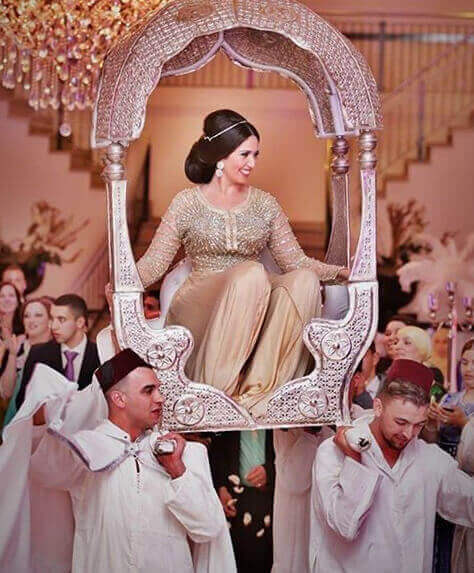
Moroccan weddings are out of this world ! A groom is required to give his bride special gifts before the big day such as sugar or henna as well as other gifts chosen by him. Two days before the wedding, custom requires the bride to go to the traditional Moroccan Hamam (sauna) with her relatives.. as it is considered an act of purification where they sing traditional songs together. The next ceremony that takes place uses the famous Moroccan Henna .. As they get a professional to draw meaningful symbols on the hands and the feet of the bride. Ceremonies differ in different cities, but what never changes is the fact that the Moroccan wedding lasts at least four to eight hours, and they use Negafa (a women who offers make-up services) to take care of the bride and how she looks. They also use an Amariya (traditional ornamental chair) for both the bride and the groom. As they lift them up in what seems to be a sort of chair. All of these are considered traditions : Whether it is the weddings or the music which we call « Dekka El Merrakchya » or the Henna that you will find offered to you everywhere on the streets or even pouring the tea making « Rezza » .. Moroccan traditions are certainly one of a kind ! And these are the traditions which truely make the Moroccan culture.
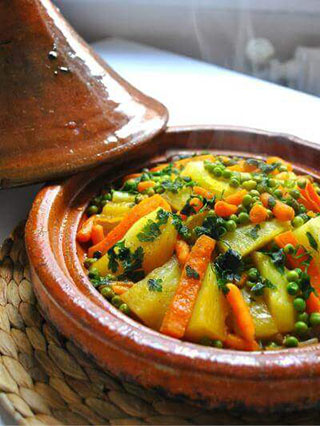
The first think any Moroccan will start telling you about when you ask him where he is from is the food ! Yes, the food, : believe it or not, it is hard to describe Moroccan food in words alone. From Pastilas to Tajines and Couscous, the meals will charm you! They are not only well cooked but also immensely detailed. Especially the spices ! Ask any Moroccan and he'd tell you how knowing how to work with spices is the most important part about Moroccan cuisine. The spices most usually used are cumin, salt, pepper, oregano, parsley, coriander, caraway and even mint! Next comes ginger, paprika, turmeric and saffron. Perhaps the most essential thing you should know about Moroccan spices is that we have a spice of our own called 'Ras El Hanout'. This spice is made out of 27 different other spices
Now, Moroccan cuisine is typically a mix of Mediterranean, Arabic, Andalusian and Berber cuisine. It is highly influenced by its interactions and exchanges with other cultures which only shows how multicultural Morocco is! The above is only an introduction to Moroccan cuisine. If you are planning on visiting us soon then perhaps consider trying the following meals : Bissara which is a soup of dried broad beans, Harira which is rich with tomatoes, lentils, chickpeas and lamb, and all spiced up with a squeeze of lemon juice and coriander, Tagine which is probably the first dish you should try! try Couscous next. And last but not least, Maakouda (a potato pancake) ! But what you should keep in mind is that even though it is only one country, you'll find each one of these dishes cooked differently in certain cities and in each home. Which is probably why you should come yourself and check out what we're talking about! Rest assured, you'll be warmly welcomed.
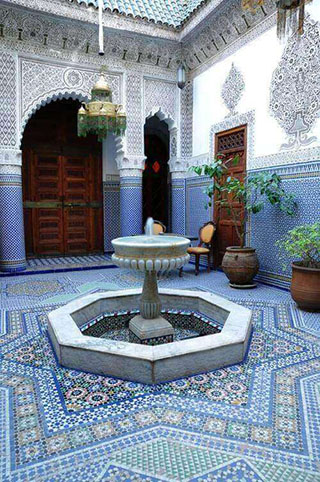
Moroccan Architecture has been greatly influenced by numerous architectural styles such as Arabic architecture for fountains, Geometric Design and Islamic calligraphy, Persians techniques for tiling concept (Zellige), Al-Andaluz Architecture (Southern Spanish) for Andalusian gardens and arches. More recent buildings are influenced by French architecture due to France occupying Morocco in 1912. That said, more modern buildings keep a balanced combination of all these architecture style, learn more about Moroccan Architecture here
Moroccan Music is one of the fundamental aspects of Morocco's culture, There are many different musical styles to be found in Morocco, each one with its own history. You can find Amazigh music from the Rif, Andalusian music from Rabat, Fes and Oujda, Chaabi from the Atlas, Ahidous from the Souss as well as Gnawa plus many more.
Learn more about Moroccan Music
To learn more about Moroccan Culture you can find some Moroccan Travel Guidebooks specialy selected for you here
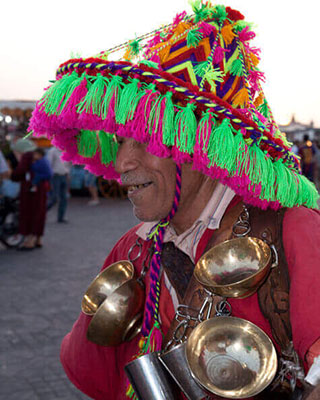
This is another one of the country characteristics, its citizen's hospitality. Moroccan people are probably ones of the nicest people you'll ever meet! They will welcome you into their homes without even the need to make sure of who you really are, they feel the need to feed you until you can not eat anymore, don't be surprised if your are invited to drink "Atay" this is the Moroccan Mint Tea, this delicious drink is composed by gunpowder tea, Sugar, water and fresh mint (or chiba - Artemisia arborescens - during winter), during the Tea ceremony they will tell you all the stories you might need or not need to know about their land and guide you through your entire journey. As for youngsters ? They'll introduce you to the mixture of culture in every possible aspect and teach you what fun really means over here.
Moroccan culture and traditions
More information about Moroccan culture .
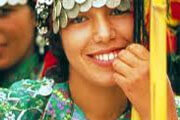
Join our Mailing List and receive electronic invitations and news about cultural events in Morocco.
→ All you need to know about Travel insurance for Morocco ←
Advertisement
Deals of the Week European Long Weekends Up to 50% OFF
Cultural Tours & Holidays in Morocco
Explore tiny villages hidden amongst the Atlas Mountains with a Berber by your side, or head to the dunes of the Sahara for a desert adventure! From the hand-made treasures in the Medina of Fes to the impressive mosques of Casablanca , a cultural tour of Morocco promises a melting pot of contrasts you're guaranteed to fall in love with.
Filters applied
250+ cultural tours of morocco with 3,553 reviews.
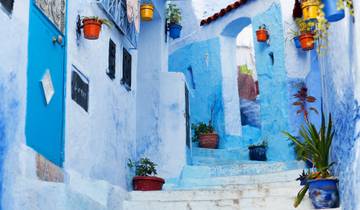
- In-depth Cultural
- Sightseeing
- Christmas & New Year
Northern Morocco: Blue Cities & Bustling Marrakech
Amazing Moroccan trip
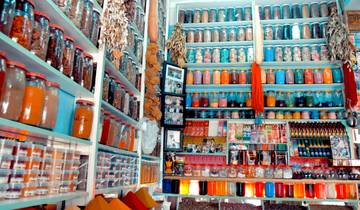
Essential Morocco
Those 11 days were among the best in my life, not only was the itinerary perfect and really diverse, our guide Mouna was a truly inspiring young female group leader, who showed us a lot of her home country. Due to the fact that the group is really small you‘ll make friends easily and I can recommend this trip to every solo traveller as well.
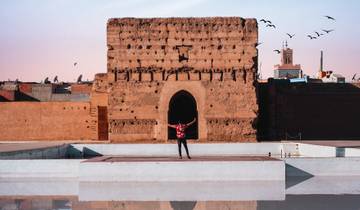
Premium Morocco Highlights
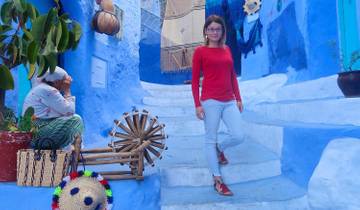
Around Morocco Tour (Guided tour/Superior Hotels)
The journey was long, but having a private vehicle and schedule made it comfortable. Our guide, Oulaid, took care of us well. The Sahara tour was the best memory.
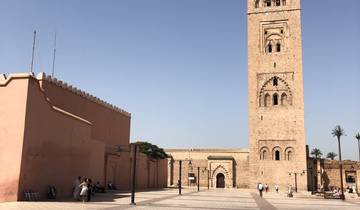
Timeless Morocco
My wife and I had an excellent time. The tour was very well organized and the guides were very knowledgeable in every location. Every location was unique and provided great examples of Morocco’s diverse landscapes, people, and ways of life. The only negative thing to mention would be the pace that was necessary in order to take everything in, but this was an adventure and not a leisure trip. We highly recommend this trip for those looking for an adventure in Morocco.
- 10% deposit on some dates Some departure dates offer you the chance to book this tour with a lower deposit.

Morocco 7 Days Tour From Casablanca
This tour consists of nice, professional driver that will take you from place to place in Morocco, rather than a tour guide that is with you for the entire 7 days. It was challenging to sit in the car for hours day to day though it is a must as some locations are 4-5 hours away from eachother. The tour included must visit cities and great accommodation and hosts. The inclusion of more guided day tours were expected at each location as you're mostly with the driver. Travelling during Ramadan was challenging for tourist food options and also for the driver towards the end of the day. Some incredible sights to see and the highlight has to be Merzouga desert!! Definitely recommend to those short on time wishing to see the highlights.
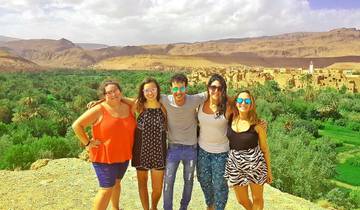
9 Days Morocco Tours From Marrakech
Had an amazing time! hassan is the best guide! Very knowledgable and helpful. Mohammad was an excellent driver. It is my first Morocco Top Travel trip and plan to do more with them! Thank you for the memorable time!

Totally Morocco - 9 days
The tour and tour guides were fantastic. There was so much to see and the explanations were excellent. The accommodation was overall poor although the hotel Adam Park in Marrakech was good and the riad in Rabat was good with a helpful and friendly manager. Other hotels were pretty poor and hotel manager in Fez was very unfriendly and unhelpful. The tour is advertised as 4 star hotel. I don't think that these as 4 star, maybe 3 stars other than Adam Park. On the other hand, the tours, transport and organization was excellent. The tour guide, Brahim was exceptional and made things easy for us. Would recommend the tour if someone is happy with 3 star not great accomodation

Morocco: Markets & Mountains
All the places we visited were great. Morocco is a country with many diverse landscapes, climates, etc. Accomodations were good for an "on a shoestring" tour, with no major problems with any of the hotels. Word of warning: the trip has a lot of winding roads and very long bus ride and much of the bus got motion sickness, so be prepared with appropriate medication if you book this tour. However, the guide and drivers accomodated for frequent breaks during the bus ride for those that got sick. The guide (Abdellah) was knowledgeable about each location, but would sometimes require a bit of prompting to talk about available options for activities to do during free time--a bit more guidance on Marrakech activities would be nice.
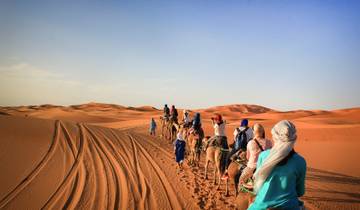
- Coach / Bus
Adventure Morocco (4 Star Hotels)
Incredible experience! Our tour guide Abdoul was fantastic-knowledgeable, interesting, fun, and made the trip an unforgettable one! Thank you!!
- €150 deposit on some dates Some departure dates offer you the chance to book this tour with a lower deposit.

6-Day Just Morocco Tour (Guided tour)
It's a bit pricey but it was great having a "personal" tour guide and driver.
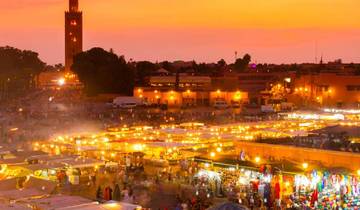
Road to Casablanca - 9 Days
We loved our tour: gives a complete perspective of Morroco both culturally and geographically. Jamal is effective, and knows what people want to see and experience.
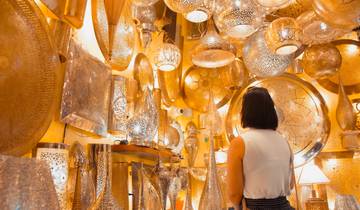
Imperial Cities
not enough english spoken by guide
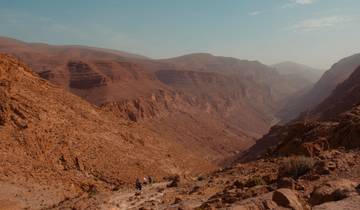
Morocco 9 Days Tour from Casablanca
Contact person (Hamid) is extremely helpful & prompt with thorough responses. The tour was way more personal/ small group than expected which was awesome. Driver &guides speak English well and are tremendously kind, flexible & patient. Hotel rooms are beautiful, great location, &great air conditioning. Morocco is amazing & MSDT makes sure to make the trip perfect. (We miss our driver as much as we miss Morocco). Chefchaouen &Fez are must see. Be sure to bring cash to exchange bc many places don’t take credit.
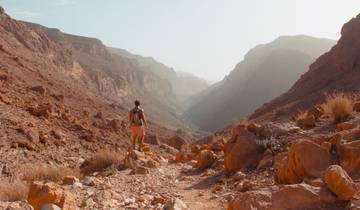
Morocco Culture and Nature Tour
More communication and details by staff
Cultural Morocco Tour Reviews
The tour was really good and had a great group. Abdul our tour guide was very knowledgeable about the places we were and we definitely had a laugh with him! He also had some good recommendations for food. The accommodation we stayed in in each place were alright, some better than others but pretty good considering the price I paid for the tour. There were a couple of things on the itinerary that were mentioned that we would see or go to that we didn't, but there were a couple of those things that we sorted ourselves between us in the group. Would definitely recommend this tour if you want to see more of Morocco than just Marrakech.
Nicely planned itinerary exploring all the essential highlights of Morocco: beautiful nature, amazing culture and tasty food; and the pacing of the road trips was also very manageable. Our tour guide Mustapha is a true gem in this trip - he answered all our questions, taught us local languages, and even arranged a surprise birthday cake for me! Definitely a trip to remember :)
This tour is really well-planned, and the staff are awesome!
In-depth Cultural Tours
- Historical (110)
- Sightseeing (61)
Regions in Morocco
- Sahara Desert (174)
- Central Morocco (130)
- Northern Morocco (107)
- Atlas Mountains (46)
- High Atlas (43)
- Mount Toubkal (25)
- Atlantic Coast Morocco (25)
- Jebel Toubkal Trek (6)
Travel Styles
- 10 Best Cultural Travel Companies
- 10 Best Cultural Experiences in The World 2024/2025
- Morocco Travel Guide | All You Need to Know
- Best 10 Morocco Vacation Packages 2024/2025

No products in the cart.
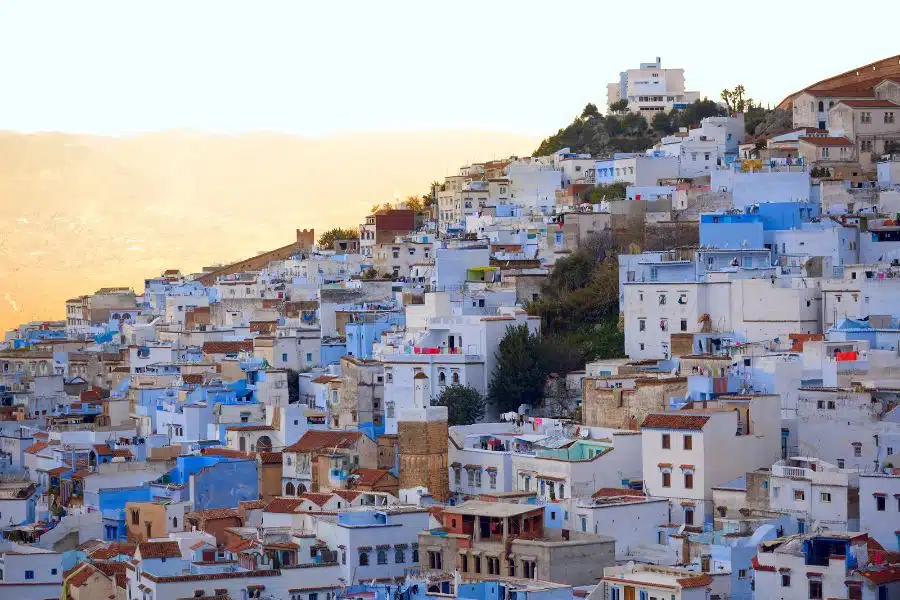
The Ultimate Guide to Morocco: Discover Exotic Beauty & Culture
Explore the best of morocco’s diverse culture, introduction: a melting pot of cultures.
Morocco , nestled between the azure waters of the Atlantic Ocean and the towering peaks of the Atlas Mountains, is a wonderland teeming with cultural riches, historic landmarks, mouth-watering cuisine, and bewitching landscapes. It’s a place where time seems to stand still, where the ancient and the modern meet in a vibrant display of color, sound, and taste. This Ultimate Guide to Morocco seeks to open the door to this mysterious and enchanting world, revealing its hidden treasures and guiding you along the paths less trodden. So, let’s pack our bags and set off on an adventure to remember!
Embark on an exclusive journey through Morocco with One Nation Travel’s Morocco private tours , where unforgettable desert escapades and historical explorations await.
The Ultimate Guide to Morocco: A Peek Behind the Curtain
Morocco – its name alone evokes images of towering minarets, bustling souks, verdant oases, and intricate geometric designs that are as mesmerizing as they are complex. But this country is more than just its captivating aesthetics. Let’s unravel the mesmerizing layers of this country in our Ultimate Guide to Morocco.
A Stroll Through Time: The History of Morocco
First, let’s delve into the historical backdrop that has shaped Morocco into the cultural powerhouse it is today. Located on the northwestern corner of Africa, Morocco is a gateway between continents, bearing witness to a myriad of civilizations and influences, from the ancient Berbers and Romans to Arabs, French, and Spanish colonial powers.
The story of Morocco is told through the ruins of Volubilis, the ancient Roman city, and the medieval alleys of Fes, boasting one of the world’s oldest universities. The fortresses of Marrakesh, the Imperial city, stand as a testament to the nation’s glorious past, while Casablanca, with its blend of Art Deco and Moorish architecture, epitomizes the country’s vibrant present.
Tapestry of Cultures: Moroccan People and Languages
The cultural fabric of Morocco is woven from a tapestry of Berber, Arab, French, and Jewish threads, among others. These diverse cultures have coexisted and intertwined over centuries, resulting in a nation characterized by tolerance, acceptance, and mutual influence.
The languages spoken mirror this cultural melange, with Moroccan Arabic, or Darija, being the most widely used. However, Amazigh languages, French, and even Spanish are not uncommon, especially in certain regions.
A Feast for the Senses: Moroccan Cuisine
No guide to Morocco would be complete without discussing its vibrant culinary scene. Moroccan cuisine is a delectable blend of Mediterranean, Berber, Arab, and French influences, utilizing a colorful palette of spices and local produce. From the famed couscous and tagine to the refreshing mint tea and heavenly pastries, Moroccan cuisine promises a gastronomic journey like no other.
Venturing into the Moroccan Landscapes: An Explorer’s Delight
Tales of the sands: sahara desert.
The awe-inspiring Sahara desert holds sway over a significant portion of Morocco. Whether you opt for a camel trek under the star-studded sky or decide to experience the life of a nomad in a Berber tent, the Sahara promises an adventure you will never forget.
Oases of Serenity: Morocco’s Palm Groves
Dotted across the arid landscapes, Morocco’s palm groves, or palmeraies, offer a welcome respite from the desert heat. These oases, teeming with date palms, fruit trees, and trickling streams, provide not only sustenance but also a unique insight into the ingenious agricultural practices of the locals.
Scaling the Heights: The Atlas and Rif Mountains
From the arid plains, we move up to the lush, verdant peaks of the Atlas and Rif Mountains. A hiker’s paradise, these ranges offer countless trails through verdant forests, Berber villages, and snow-capped peaks. For those seeking solitude and tranquillity, the crisp mountain air and sweeping vistas provide an unbeatable retreat.
Diving into the Bustling Cities and Ancient Medinas
Where traditions meet modernity: marrakesh.
No trip to Morocco would be complete without visiting Marrakesh, a city where past and present coexist in an enchanting dance. From the bustling Jemaa el-Fnaa square to the serene Majorelle Garden, Marrakesh offers a captivating blend of sights, sounds, and experiences.
Journey through History: Fes
As one of the world’s oldest continually inhabited cities, Fes is a journey back in time. The labyrinthine streets of the medina, brimming with artisan shops, food stalls, and ancient mosques, invite visitors to lose themselves in a bygone era.
The Blue Pearl: Chefchaouen
Tucked away in the Rif Mountains, Chefchaouen, or the Blue Pearl, captivates visitors with its blue-washed buildings and relaxed pace. Whether you’re strolling through the cobbled lanes, savoring local delicacies, or soaking in the spectacular views from the Spanish Mosque, Chefchaouen is a feast for the senses.
FAQs: The Ultimate Guide to Morocco
1. What is the best time to visit Morocco?
The best time to visit Morocco depends on the region you plan to explore. Spring (April to June) and fall (September to November) offer the most pleasant weather for most of the country. However, if you plan to visit the Sahara desert, the cooler months of November to February would be more suitable.
2. Is it safe to travel to Morocco?
Yes, Morocco is generally safe for travelers. However, like any travel destination, it’s essential to take standard precautions, such as avoiding deserted areas at night and safeguarding valuables.
3. What currency is used in Morocco?
The official currency of Morocco is the Moroccan Dirham (MAD). Many shops and restaurants in larger cities also accept credit cards.
4. Do I need a visa to travel to Morocco?
Visa requirements for Morocco vary depending on your country of residence. As of now, citizens of over 60 countries, including the US, Canada, and the UK, can enter Morocco without a visa for up to 90 days.
5. What language is spoken in Morocco?
Moroccan Arabic, or Darija, is the most commonly spoken language. Berber languages are also widely spoken, especially in rural areas. Many Moroccans speak French, and English is becoming increasingly prevalent, particularly among the younger population.
6. What should I wear in Morocco?
Morocco is a predominantly Muslim country, so it’s recommended to dress modestly, especially when visiting religious sites. Loose-fitting clothes that cover your shoulders and knees are generally acceptable. However, in tourist areas and larger cities, dress codes are more relaxed.
Top 3 Exceptional Tour Packages for an Unforgettable Moroccan Adventure
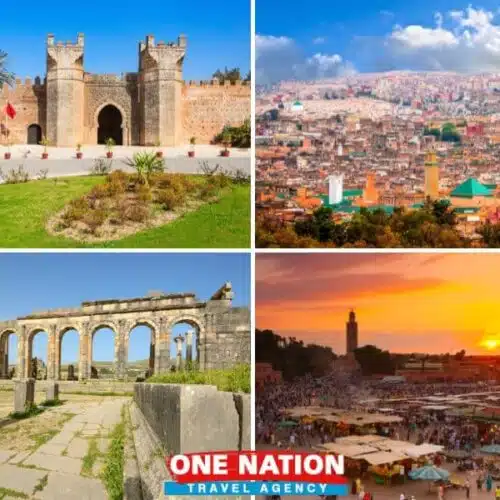
Similar Posts

A Complete Guide to Planning a Trip to Morocco
Explore the enchanting world of Morocco using our all-inclusive guide, featuring visa info, top attractions, travel tips, and more for an unforgettable trip.

Is It Safe to Travel to Morocco in 2023
Explore Morocco with confidence! Learn about the country’s safety, and follow our tips for a worry-free trip. Embrace the culture and create unforgettable memories.

Can Americans Travel to Morocco
Find out if Americans can journey to Morocco with our comprehensive guide. Uncover visa info, ideal travel times, must-see attractions, and beyond. Dive in!

Discovering the Wonders of Morocco: Your Ultimate Guide to Transportation
Discover the ideal ways to navigate Morocco. Dive into a range of transportation choices including trains, buses, taxis, and car rentals, complemented by insightful tips for a smooth and memorable journey across this captivating country.
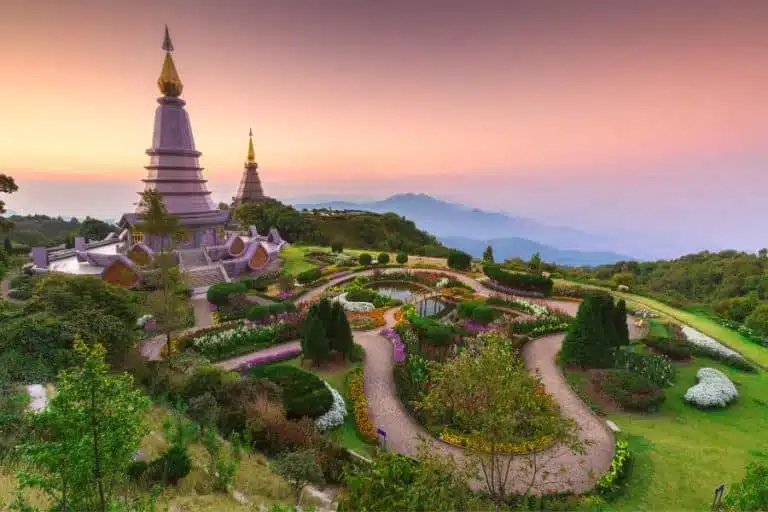
The 6 Most Popular Travel Destinations for Americans in 2024
Explore the six most popular travel destinations for American travelers – Egypt, Turkey, Greece, Jordan, Morocco, and Thailand – offering a wealth of cultural experiences, historical sites, and thrilling adventures.

Top 15 Must-See Attractions in Morocco: A Traveler’s Guide
Discover the top 15 attractions in Morocco, from the bustling souks of Marrakech to the serene Sahara Desert. Perfect for adventurers and culture seekers.
START PLANNING YOUR TRIP
Our team of experts have a wealth of knowledge and experience to help you plan your adventure of a lifetime.
A travel guide to Moroccan culture and etiquette
Recently updated on August 14th, 2023 at 03:19 pm
With beautiful scenery, vibrant cities, rich culture, delicious cuisine and friendly locals, Morocco is an incredible destination. It’s also home to many unique Moroccan traditions and etiquette rules, so it’s best to brush up on your cultural knowledge before you visit. Not only will you have a much more enriching experience, but the locals will really appreciate you making the effort to respect their customs. From what to wear to how to eat, here is everything to know about Moroccan culture and etiquette before you go.
View this post on Instagram A post shared by Visit Morocco (@visit_morocco_)
Greetings in Moroccan culture are more formal, yet very warm and welcoming. Moroccans will say “salaam alykum” (hello) to everyone, even in large gatherings and they’ll ask about your health and the wellbeing of your family and children. People from the same sex will usually shake hands or greet with two “air kisses” on both cheeks, but this is never done between opposite sexes unless they know each other very well.
If a man is greeting a woman, he waits for her to extend her hand for a handshake. If she doesn’t, he should bow his head as a greeting. You should always greet with your right hand, as the left is considered unclean. During the coronavirus pandemic, Moroccans switched up their greetings and now often touch elbows or place their left hand on their heart after nodding and greeting with “salaam alykum”.
EXPERIENCE IT FOR YOURSELF: Best of Morocco
How to dress in Morocco
Morocco is a conservative country and you should always dress modestly when travelling here. Men should wear a t-shirt or collared shirt covering the shoulders and long trousers or shorts that reach the knee. Women should wear long, loose-fitting clothing that covers your upper arms, knees, chest, midriff and back. It’s not necessary for foreign women to cover their hair, but you will need to do so when visiting a mosque, so bring a scarf for extra modesty. Swimwear should only be worn at the beach and you should always cover up before leaving the beach.
If you are visiting a rural area, it’s important to be even more conservative and cover your arms and legs. The cities are a bit more relaxed but the locals appreciate it if you respect the Moroccan culture by dressing modestly. As for shoes, bring some comfy sandals, as you’ll find yourself slipping them off quite a lot when you enter homes and religious sites.
Remember, if you’re visiting during Ramadan, you should dress even more conservatively. Also, you won’t be expected to fast, but it is polite to eat, drink and smoke indoors away from the locals who are fasting during this holy month.
RELATED CONTENT: Our guide to everything you need to know before travelling to Morocco
Public displays of affection
While you may often see people of the same sex hugging and holding hands in Morocco, this is only a sign of friendship. Public displays of affection between opposite sexes such as kissing are not allowed, while homosexuality is illegal in Morocco.
If you need to beckon someone, don’t use your index finger to motion a person over, as this is considered very rude in Moroccan culture. Instead, place your palm downward and sweep the hand toward yourself.
Domestic etiquette in Morocco
Moroccans are famously friendly and you might even meet people who invite you to their homes for a meal. When you travel to Morocco with Trafalgar, you’ll also get the unique opportunity to enjoy meals with local families in their homes. So what should you know about Moroccan culture in the home?
The first thing to do is to remove your shoes before entering. Your host will offer you indoor slippers or you can go barefoot. It is then polite to chat with your host before they offer you tea or coffee and sweets. It’s also a Moroccan tradition to bring a gift for the host like pastries or tea.
Table etiquette in Morocco
Before the meal, you should always wash your hands. Your host might even bring a washing basin to the table before the meal is served. But don’t dig in just yet! You shouldn’t start eating until the host blesses the food and says “bismillah”, meaning “in the name of God”. When you begin the feast, always remember to use your right hand for eating.
Moroccans often use their hands to eat, rather than a knife and fork, but there’s a trick to it. You should hold the bread between your fingers and use your thumb as a scoop… Practice a bit and you’ll be a pro in no time! Moroccan food is delicious and it can be tempting to want to try everything on the table. But if you’re eating from a communal plate in a home, you should only take what is immediately in front of you, unless you’re offered something by the host.
RELATED CONTENT: 5 soul-stirring Moroccan food experiences you can enjoy with Trafalgar
Tipping etiquette in Morocco
It is customary to tip service staff like waiters, porters, taxi drivers, hotel staff and more in Morocco. You should aim to tip around 10 to 15% and it’s always appreciated.
The art of haggling
Morocco is famous for its vibrant souks (traditional markets), selling everything from spices and tea to lanterns, leather goods and clothing. It’s hard to resist loading up on souvenirs in these enchanting places – so you’ll need to learn the art of haggling . It’s a huge part of Moroccan culture and most locals haggle when buying anything from food to carpets.
The general rule is to never pay more than 70% of the original (and inflated) starting price, and your first offer should be around 50% less than the asking price. If the vendor doesn’t offer you a reasonable deal, you’re not pressured to buy anything and you can walk away. But also remember to remain polite and friendly, and don’t take it too seriously… It’s all part of the fun of shopping in Morocco!
EXPERIENCE IT FOR YOURSELF: Spain, Morocco and Portugal
Don’t criticise the Moroccan monarchy
Morocco has lèse–majesté laws which means it’s illegal to criticise, mock or speak badly about the Moroccan king and the royal family. Defacing the king’s image is also illegal, and breaking these laws could actually land you in jail, so keep your royal opinions to yourself in Morocco.
Don’t disrespect Islam
Another big no-no is criticising Islam. More than 99% of the Moroccan population are Muslim and Islam is the state religion of Morocco. If you disrespect Islam here, you risk offending the locals, and no traveller should go out of their way to be rude to their host. While it’s fine to ask questions in a genuine attempt to learn more about the religion, you should avoid sharing any controversial opinions that may upset the locals.
Also remember that non-Muslims are forbidden from entering certain areas like shrines, mosques, graveyards and koubas (tombs of marabouts or local saints). Even if you’re near a mosque, you should be very respectful and never get too close or look inside, especially if you’re taking a photo. The main exception to this rule is the famous Hassan II Mosque in Casablanca and it’s a wonderful experience to see the intricate Islamic architecture up close here.
Ask before taking photos
It’s hard to resist taking hundreds of photos a day in this incredible country, but it’s important to be respectful of the locals when getting snap happy. Most Moroccans don’t appreciate being photographed, so you should always ask permission first.
If you’re visiting the famous Jemaa el-Fna square in Marrakesh, you’ll need to pay before taking photos of all the amazing dancers, artists and entertainers there, so remember to ask the price before clicking away. You should also know that it’s illegal to take photos of border checkpoints and police and military figures and buildings in Morocco.
RELATED CONTENT: 9 ways to ensure you’re a culturally sensitive traveller
Languages in Morocco
Moroccans are skilled at speaking many languages, and you’ll likely hear everything from Arabic (the official language), to Darija (the local Moroccan dialect). French is also widely spoken in cities, while Spanish is spoken in Tangier. There’s also the dialects spoken by the Berber people, including Tarifit, Tachelhit and Tamazight.
While you might be able to get by with English in the main tourist areas like Marrakesh, Fes and Casablanca, it will be more helpful to learn a few common phrases in Arabic as this is spoken country-wide. You should never expect anyone to speak English, but don’t worry if you don’t speak perfect Arabic – your local Trafalgar Travel Director will be able to help you out with any translations.
Are you dreaming of a trip to Morocco? Let us know in the comments below!
Want to hear more from us?
Sign up to receive inspiring travel articles, offers & news
" * " indicates required fields
Privacy Overview
Sign up for our emails.
Latest Articles
The ultimate luxury getaway on the moroccan coast.

From Marrakech to Casablanca - A Tale of Two Moroccan Cities

Culture Trip's Top Five Destinations for 2024

The Ultimate Guide to Holidays in Marrakech

The Best Trips for Desert Adventures

The Best Trips and Tours in Morocco

Ouarzazate - Morocco’s Hidden Hollywood Gem in the Desert

Local Insider - Highlights from Culture Trip's Epic Adventure to Morocco

Why Travelling Abroad for Christmas is a Great Idea

Inspiration
Get inspired to travel. explore lgbtq+ travel experiences, hidden stories, and the unique attractions that make a destination worth visiting., the luxury desert stay close to the heart of marrakech.

Where to Stay and Go in Casablanca: the Best Hotels and Neighbourhoods

A Go-To Guide to Skiing in Morocco's Oukaïmeden Mountain

The Mellah: Discovering the Hidden Jewish History of Marrakech

The Stories Behind Marrakech’s City Gates

Hungerlust: Tanjia, the Moroccan Dish Made With Fire and Friendship

How to Trek Morocco's Atlas Valley

This Moroccan Village Is an Iconic Game of Thrones and Famous Film Set

10 Fitness Trends in Morocco

Tree-climbing goats in Morocco

Small Groups, Big Adventures 640x382 3

Things To Do
Plan your sightseeing and activities with our recommendations. explore attractions, book tours, and immerse yourself in the local culture., glamping under the stars in the sahara desert, morocco.

Things to See and Do in Derb Ghallef, Casablanca

How Supporting Local Projects in Marrakech Can Protect Tourism and the Environment

The Best Souvenir Shopping spots in Casablanca, Morocco

The 6 Best Surf Experiences in Agadir, Morocco

A Local’s Guide to Water Sports in Essaouira

Stay Curious: Experience Morocco From Your Living Room

A Guide To Visiting Volubilis, Morocco

Hidden Gems to Explore in Marrakech

Immerse yourself in the local arts, literature, and design. Explore the cultural fabric of the destination through art, literature, and design.
Travel the world virtually with immersive sonic escapes.

How Moroccan Youth Are Using Trap Music To Express Themselves

Meet the Tattooed Berber Women of the Atlas Mountains

7 Ancient Sites in Morocco That You Probably Haven’t Heard Of

Meet Morocco’s Gunpowder Girls

How Morocco’s Atlas Film Studios Became the World’s Biggest Film Set

The Top 8 Highlights of Jewish Marrakech

Welcome to Hassan Hajjaj's Marrakech

Finding Paradise in Marrakech’s Riad Gardens

Guides & Tips
Get expert guidance for your trip. from tips on packing to cultural etiquette, our travel advice will help you make the most of your journey., why tangier is the perfect gateway to morocco.

Food & Drink
Explore the local culinary scene, from breakfast to michelin-starred restaurants. sip cocktails, savor desserts, and discover the best local markets., the best cafés in rabat, morocco.

The Best Moroccan Desserts You Need To Try

Casablanca: The Ultimate Vegan Guide

An Insider’s Guide to the Best Bars in Marrakech

Breakfast in Marrakech: What To Eat and Where To Eat it

10 Top Spots for Bastilla in Casablanca

10 Top Spots for Tajine in Fez

9 Top Spots for Tajine in Marrakech

10 Top Spots for Couscous in Casablanca

Places To Stay
Find the perfect place to stay. whether you prefer boutique hotels, luxury resorts, or budget hostels, we have recommendations for you., the best hotels to book in agadir, morocco.

The Best Surf Camps in Morocco

The Best Hotels in Fez for Every Traveller

The Best Hotels in – and near – the Medina in Marrakech

The Best Hotels to Book in Essaouira, Morocco, for Every Traveller

The 10 Best Luxury Hotels in Marrakech

The Best Hotels to Book in Marrakech, Morocco

The Best Cheap Hotels to Book in Marrakech

The Best Hostels in Marrakech, Morocco


Morocco Culture: A Fascinating Blend of Arab, Berber, and European Influences

Affiliate Disclaimer
As an affiliate, we may earn a commission from qualifying purchases. We get commissions for purchases made through links on this website from Amazon and other third parties.
Morocco is a country located in North Africa, known for its diverse and rich culture. The country’s culture is a blend of Arab, Amazigh, Jewish, African, and Western European cultures. Morocco’s unique culture is shaped by a convergence of influences throughout history.
Morocco’s culture is known for its hospitality, music, art, and cuisine. The country has a rich history and a deep appreciation for tradition. Moroccan culture is also known for its acceptance of differences, making it a welcoming place for visitors from all over the world. From the bustling markets of Marrakech to the serene beaches of Essaouira, Morocco offers a unique and unforgettable cultural experience.
Moroccan People and Ethnicity
Morocco is a country located in North Africa with a population of over 37 million people. The Moroccan people are a diverse group, with the two major ethnic groups being the Arabs and the Berbers. The Arabs arrived in Morocco as early as the late 8th century and conquered much of the coastal region. They established dynasties in Morocco and together with native Moroccan Berbers, extended control to what is now southern Spain and Portugal. The Berber people are the indigenous group of Morocco and have lived in the region for more than four millennia.
The Moroccan population is primarily of Arab and Berber origin, with the Arab population making up 44% of the population, and the Berber population making up 21%. The remaining 35% of the population is made up of Arabized Berbers, Baydhan, and other ethnic groups.
In addition to the Arab and Berber populations, Morocco has a small Jewish population, which has been present in the country for over 2,000 years. The African and Western European influences have also left their mark on Moroccan culture, making it a unique blend of various cultures.
The Berber people have their own language, which is called Tamazight, and it is spoken by around 40% of the population. Arabic is the official language of Morocco, and it is spoken by almost the entire population. French is also widely spoken, especially in business and education.
Overall, the Moroccan people are a diverse group with a rich cultural heritage that is shaped by a convergence of influences throughout history.
Language and Communication
Morocco has a rich linguistic landscape, which reflects its diverse cultural heritage. The official language of Morocco is Arabic, specifically the Moroccan Arabic dialect known as Darija. Darija is the most widely spoken language among the local population. Classical Arabic, a formal rather than natural language, is used primarily in formal, academic, and religious settings. Hassaniya is another dialect of Arabic spoken in the south of Morocco. French is also widely spoken, and it is the language of business, government, and education. Spanish and English are less common, but they are also spoken in some parts of the country.
Language plays a significant role in Moroccan culture, and understanding the linguistic landscape will enhance your travel experience in Morocco. Road signs, menus, and business signs are typically written in French. Knowing French food words might be helpful to you as you order in restaurants. You will also find signage in Arabic and Berber.
In terms of communication, Moroccans are generally friendly and hospitable, and they appreciate visitors who make an effort to speak their language. If you are planning to visit Morocco, it is a good idea to learn some basic Arabic phrases, such as “salaam alaikum” (hello), “shukran” (thank you), and “maa salaama” (goodbye). Knowing some French words and phrases can also be helpful. Moroccans are generally patient with non-native speakers, and they will appreciate your efforts to communicate with them in their language.
Overall, Morocco’s linguistic diversity is a reflection of its rich cultural heritage. While Arabic is the official language, French is also widely spoken, and other languages such as Spanish and English are also used in some parts of the country. Understanding the linguistic landscape will enhance your travel experience in Morocco, and making an effort to communicate with locals in their language will be appreciated.
Religion and Beliefs
Morocco is a predominantly Muslim country, with Islam being the state religion. Approximately 99% of the population adheres to Islam, with the majority being Sunni Muslims. The country has a long Islamic history and is home to many beautiful mosques and religious sites.
While Islam is the dominant religion in Morocco, the country has a diverse religious landscape. There is a small Jewish population, with Judaism having the longest history of religions in Morocco, dating back to the Carthaginian era in 500 BC. Additionally, there is a small Christian population in Morocco, with Catholicism being the largest denomination.
The Moroccan constitution guarantees freedom of religion, but the government has been criticized for discriminating against non-Muslims and non-religious individuals. Blasphemy against Islam is a punishable offense, and those who convert from Islam to another religion may face persecution.
Despite these challenges, Morocco has a rich religious and cultural heritage that is celebrated throughout the country. Religious festivals, such as Ramadan and Eid al-Fitr, are widely observed, and many Moroccans visit religious sites and participate in religious ceremonies.
Overall, religion plays an important role in Moroccan society, shaping everything from personal beliefs to cultural traditions. While Islam is the dominant religion, the country’s diverse religious landscape reflects the many influences that have shaped Moroccan culture throughout history.
Art and Architecture
Moroccan art and architecture are known for their unique blend of different cultural influences, resulting in a distinctive style that is both visually stunning and historically significant. Moroccan architecture is characterized by intricate geometric patterns, vibrant colors, and elaborate ornamentation.
One of the most famous examples of Moroccan architecture is the use of zellige, a type of mosaic tilework that is made up of small, individually cut pieces of tile. Zellige is used to decorate everything from walls and floors to fountains and columns, and its intricate patterns and vibrant colors make it a hallmark of Moroccan design.
Moroccan architecture also features many examples of carved doors, which are often made from wood and feature intricate designs and patterns. These doors are not only functional but also serve as beautiful works of art, adding to the overall aesthetic of a building.
Moroccan art also encompasses a wide range of visual arts, including painting, sculpture, and calligraphy. Traditional Moroccan art often features geometric patterns and bold colors, and many artists draw inspiration from Islamic art and design.
In addition to traditional art forms, Morocco is also home to a thriving contemporary art scene, with many galleries and museums showcasing the work of both established and emerging artists.
Overall, Moroccan art and architecture are a testament to the rich cultural history of the country, and their unique blend of influences has resulted in a style that is both visually stunning and culturally significant.
Traditional Clothing
Moroccan traditional clothing is an essential aspect of the country’s rich culture. It is a reflection of the country’s history, identity, and diverse cultural influences. Traditional clothing for both men and women in Morocco consists mostly of long robes with hoods, headscarves, and traditional slippers. These magnificent dresses have been worn since ancient times and are still used today.
The djellaba is a long, loose-fitting robe with a hood that is worn by both men and women. It is made of wool or cotton and is perfect for the country’s hot climate. The djellaba is a practical garment that is worn for everyday use and special occasions. It is available in various colors and designs, and it is often adorned with intricate embroidery.
The kaftan, also known as a caftan, is another long and flowing type of robe-like dress worn in Morocco. Unlike the djellaba, though, the kaftan is only worn by women. Historically, however, it was the ceremonial dress of judges. The kaftan is made of silk or cotton and is usually adorned with intricate embroidery, beads, and sequins. It is a popular choice for special occasions such as weddings, parties, and other formal events.
The takshita is another popular traditional dress for women in Morocco. It is a two-piece garment consisting of a long-sleeved top and a skirt. The top is usually made of silk or satin and is adorned with intricate embroidery, beads, and sequins. The skirt is made of a flowing fabric such as chiffon and is usually lined with silk or satin.
In conclusion, traditional clothing in Morocco is a reflection of the country’s rich culture and history. The djellaba, kaftan, and takshita are just a few examples of the magnificent dresses that are still being used today. These garments are not only practical but also beautiful and intricate, making them a significant part of the country’s cultural heritage.
Moroccan Cuisine
Moroccan cuisine is a blend of Berber, Andalusian, Mediterranean, and Arab cuisines with minimal European and sub-Saharan influences. It is known for its diverse and flavorful dishes that incorporate a wide range of spices and herbs. Moroccan cuisine is a reflection of the country’s rich history and culture, influenced by the many cultures and nations that have interacted with Morocco over the centuries.
One of the most famous Moroccan dishes is couscous, which is a staple food in the country. It is made from semolina grains and steamed vegetables, and often served with lamb or chicken. Moroccan cuisine is also known for its use of spices, such as cumin, ginger, saffron, and paprika. Ras el hanout, a spice blend consisting of up to 30 different spices, is commonly used in Moroccan cuisine.
Moroccan food is often cooked in a tajine, a clay pot with a conical lid that helps to retain moisture and flavor. Tajine dishes can be sweet or savory, and often incorporate meat, vegetables, and fruits. Lamb is a popular meat in Moroccan cuisine, and it is often seasoned with mint or other herbs.
Moroccan cuisine is characterized by its sweet and savory flavors, and many dishes incorporate dried fruits, such as dates and apricots, and honey. Mint is also a common ingredient in Moroccan cuisine, and it is often used to flavor tea, salads, and meat dishes.
Overall, Moroccan cuisine is a reflection of the country’s diverse cultural heritage and is known for its flavorful and aromatic dishes.
Music and Dance
Moroccan music and dance are deeply rooted in traditional culture. Music plays an important role in everyday life, with various styles and instruments used to express emotions or tell stories. There are more than 700 dance and music festivals every year, and each region has its own particular flavor.
Moroccan music varies greatly between geographic regions and social groups. It is influenced by musical styles including Arab, Berber, Andalusi, Mediterranean, Saharan, West African, and others. Musical styles vary by geography. For example, the Gnawa music of the southern region of Morocco is heavily influenced by sub-Saharan African music. It is characterized by the use of the guembri (a three-stringed bass instrument), krakebs (metal castanets), and call-and-response vocals.
Traditional dances, such as the Ahidus, Aarfa, and Guedra, are still performed during ceremonies and special occasions. The Ahidus dance is a group dance performed by the Berber people of the Atlas Mountains. It is characterized by the use of drums, flutes, and hand clapping. The Aarfa dance is a popular dance performed by the Chaouia people of the eastern region of Morocco. It is characterized by the use of drums, cymbals, and a large number of dancers. The Guedra dance is a trance dance performed by the women of the Saharan region of Morocco. It is characterized by the use of a large drum, hand clapping, and chanting.
Moroccan music has gained international recognition in recent years, with artists such as Rachid Taha and Amadou & Mariam gaining worldwide acclaim. Moroccan music festivals are popular tourist attractions, with the Gnawa World Music Festival in Essaouira and the Festival of World Sacred Music in Fez being two of the most popular.
Family and Society
Family is the most significant unit of Moroccan life and plays an important role in all social relations. Moroccan families are typically large and extended, with several generations living together under one roof. Family members are expected to support and help each other in times of need, and loyalty to the family is highly valued.
Moroccan law is based on Islamic law, which places a strong emphasis on family and community. Family law is regulated by the Moudawana, a set of laws that governs marriage, divorce, and inheritance. Moroccan women have made significant progress in recent years in terms of their legal rights, but there is still room for improvement. For example, women still face discrimination in inheritance rights, and domestic violence remains a significant issue.
Moroccan customs and traditions are deeply rooted in family and community. Hospitality is an essential part of Moroccan culture, and guests are treated with great respect and generosity. Moroccan cuisine is also an important part of family life, with meals often being prepared and eaten together.
Moroccan traditions are diverse and reflect the country’s rich history and cultural heritage. Traditional Moroccan clothing, such as the djellaba and kaftan, are still worn today, particularly on special occasions. Moroccan music and dance are also an important part of the country’s cultural heritage, with many traditional instruments and styles still being used today.
Overall, family and society are central to Moroccan culture, with strong emphasis placed on community, hospitality, and tradition. While there are still challenges to be addressed, such as gender inequality and domestic violence, Morocco’s rich cultural heritage and traditions continue to play an important role in shaping the country’s society and way of life.
Festivities and Celebrations
Morocco is a country of diverse cultures and traditions, and its festivals and celebrations reflect this diversity. The country celebrates both religious and secular events throughout the year, offering visitors a unique opportunity to experience Moroccan culture firsthand.
One of the most important religious celebrations in Morocco is Ramadan, which is observed by Muslims worldwide. During this month-long period, Muslims fast from dawn until dusk, and families come together to break their fast in the evening. Visitors to Morocco during Ramadan will find a unique atmosphere, with special foods and drinks served during the evening hours.
Moroccan weddings are also a significant event, with elaborate ceremonies that can last for several days. The wedding ceremony is often accompanied by traditional music and dancing, and the bride is dressed in a stunning traditional outfit. The Negafa, a professional wedding planner, ensures that every detail of the wedding is perfect.
The Hamam, or public bathhouse, is another important cultural tradition in Morocco. The Hamam is a place where people come to relax, socialize, and cleanse their bodies. Visitors to Morocco can experience the Hamam for themselves and enjoy a traditional Moroccan massage.
The Amariya is a traditional Moroccan bridal procession that takes place before the wedding. The bride is accompanied by her female family members and friends, who sing and dance their way through the streets. The Amariya is a colorful and joyous celebration that is not to be missed.
Overall, Morocco’s festivals and celebrations offer a unique insight into the country’s rich cultural heritage. Whether you’re interested in religious events, weddings, or traditional customs, there’s something for everyone to enjoy in Morocco.
Literature and Poetry
Moroccan literature and poetry have a rich history and continue to thrive today. The country’s unique blend of Arab, Amazigh, Jewish, African, and Western European cultures has resulted in a diverse literary scene that incorporates various languages, including Arabic, Tamazight, and French.
Moroccan literature dates back centuries, with notable works including the epic poem “Bayad wa Riyad” by Al-Tutili and the travelogue “Rihla” by Ibn Battuta. In modern times, Moroccan literature has continued to grow and diversify, with forms inspired by Middle Eastern and Western literary models. Some of the most prominent Moroccan writers include El Majdoub, Awzal, Choukri, Ben Jelloun, Zafzaf, El Maleh, and Chraibi.
Moroccan poetry is also an important aspect of the country’s literary tradition. Traditional poetic forms such as ghazals and qasidas are still popular, but contemporary poets have also experimented with free verse and other forms. The collection “Poetic Justice” brings together work by more than 80 contemporary Moroccan poets writing in Darija, standard Arabic, French, and Tamazight.
In addition to literature and poetry, knowledge has also played a significant role in Moroccan culture. The country has a long history of scholarship, with important centers of learning such as the University of Al Quaraouiyine in Fez. Today, Morocco continues to promote education and knowledge through initiatives such as the National Initiative for Human Development, which aims to improve literacy rates and access to education for all Moroccans.
Influence of Foreign Cultures
Morocco’s culture has been shaped by a variety of foreign influences throughout its history. The country’s proximity to Europe and its location as a crossroads between Africa, the Middle East, and Europe have made it a prime location for cultural exchange.
French Influence
French influence in Morocco can be traced back to the early 20th century when the country became a French protectorate. The French introduced many aspects of Western culture to Morocco, including French language, fashion, and cuisine. Today, French is still widely spoken in Morocco, especially in urban areas, and French influence can be seen in the country’s architecture, cuisine, and education system.
Spanish Influence
Spain also played a significant role in shaping Morocco’s culture. Spain occupied parts of Morocco in the early 20th century, and Spanish influence can be seen in the country’s music, dance, and language. Spanish is still spoken in some parts of Morocco, particularly in the north, and Spanish influence can be seen in the country’s architecture and cuisine as well.
English Influence
While not as significant as French or Spanish influence, English has also had an impact on Morocco’s culture. English is widely taught in Moroccan schools and universities, and many young Moroccans are fluent in English. English influence can be seen in the country’s music, fashion, and business culture.
Western Influences
Morocco has also been influenced by Western culture more broadly. Western music, movies, and television shows are popular in Morocco, and many young Moroccans are familiar with Western fashion and trends. Western influence can be seen in the country’s urban areas, where young people often dress in Western-style clothing and listen to Western music.
Foreign influence has played a significant role in shaping Morocco’s culture. French, Spanish, and English influence can be seen in the country’s language, music, cuisine, fashion, and architecture, while Western influence more broadly has impacted the country’s popular culture. Despite these foreign influences, Morocco has maintained a unique cultural identity that is a blend of Berber, Arab, and European influences.
Frequently Asked Questions
What are some traditional moroccan customs and traditions.
Morocco has a rich cultural heritage, and there are many traditional customs and traditions that are still observed today. One such tradition is the Moroccan tea ceremony, where mint tea is served to guests in a special way. Another is the use of henna to decorate the hands and feet of brides and guests at weddings. Moroccan clothing is also a reflection of its culture, with the traditional djellaba and kaftan being popular choices for both men and women.
What are some cultural norms and values in Morocco?
Moroccan culture places a strong emphasis on hospitality and respect for elders. It is also a collectivist culture, where family and community are highly valued. Gender roles are still somewhat traditional, with men typically being the breadwinners and women taking care of the home and family. Islam is the dominant religion, and religious values and practices are an important part of daily life.
What is the role of family in Moroccan culture?
Family is a central part of Moroccan culture, and the extended family is often involved in decision making. Respect for elders and taking care of one’s parents is highly valued. Family gatherings and celebrations are also an important part of Moroccan culture, with weddings and religious holidays being particularly significant.
What are some common religious practices in Morocco?
Islam is the dominant religion in Morocco, and religious practices are an important part of daily life. Muslims are expected to pray five times a day, and the holy month of Ramadan is observed with fasting during daylight hours. Other religious practices include the pilgrimage to Mecca, known as the Hajj, and the celebration of Eid al-Fitr and Eid al-Adha.
How has Moroccan culture evolved over time?
Moroccan culture has been influenced by many different civilizations, including the Berbers, Arabs, and Europeans. The country’s strategic location on trade routes between Europe, Africa, and the Middle East has also played a role in shaping its culture. Today, Morocco is a blend of traditional and modern influences, with a rich cultural heritage that is still celebrated and preserved.
What are some unique aspects of Moroccan language and dialects?
Morocco has two official languages: Arabic and Berber. Moroccan Arabic, also known as Darija, is the most widely spoken language and has many unique dialects. French is also widely spoken, particularly in business and education. Moroccan Arabic has borrowed words from French, Spanish, and other languages, making it a unique and diverse language.
About the author
Latest posts

History of Tangiers: The Crossroads of Civilizations
Delve into Tangier’s tapestry of time, where ancient tales meet modern narratives.

Day Trip Tangier: Exploring Morocco’s Northern Gem in One Day
Imagine a city where the rhythmic beats of Africa meet the melodic tunes of Europe, where the Atlantic kisses the Mediterranean, and where history and modernity walk hand in hand. Welcome to Tangier.

Best Places to Stay in Tangier: A Comprehensive Guide
From historic riads to luxurious resorts, Tangier’s accommodations are as diverse and enchanting as the city itself.
18 things to know before traveling to Morocco

Oct 15, 2023 • 7 min read
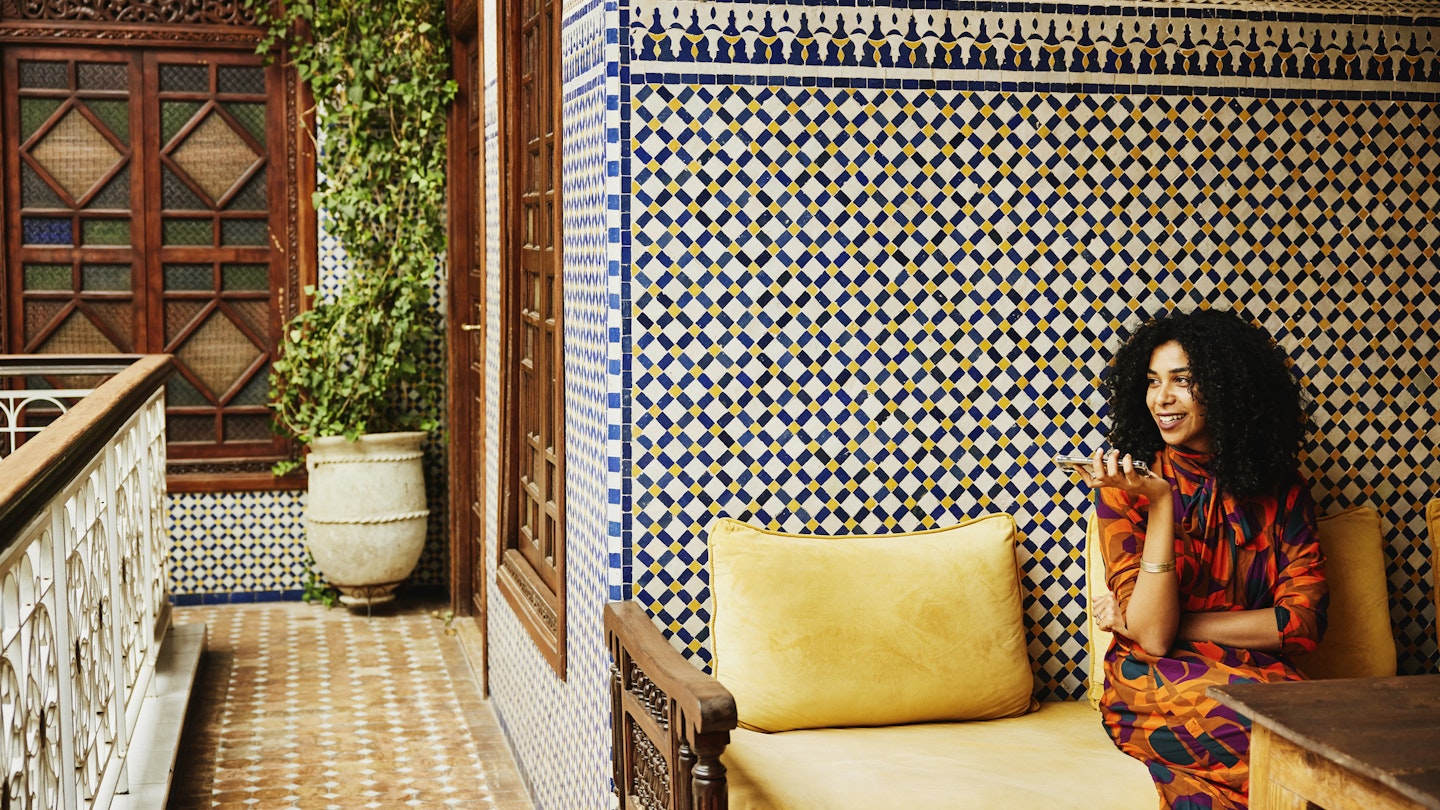
It helps to learn a little lingo: here's what to know before your trip to Morocco © Thomas Barwick / Getty Images
I am originally from the UK and have been living in Morocco since 2018. There are things I wish I'd known before jumping headfirst into the seemingly lawless world of Moroccan taxis and bargaining in the souqs.
Morocco reveals the full spectrum of real life: the good, the bad, the ugly and the oh-so beautiful. For some visitors, Morocco can be a huge culture shock. But with some awareness and understanding, it is possible to appreciate these differences, connect more deeply and see the country through a different lens without trying to change it.
1. Plan your itinerary loosely and allow for changes
Research the places in Morocco you’d like to visit but leave wiggle room for changes along the way and enjoy the spontaneity that Morocco allows. While it’s possible to pre-book tours and activities, it’s usually just as easy to reserve them when you arrive in the country.
2. Take public transport, especially in cities
Driving in cities such as Casablanca and Marrakesh is best left to the locals. Getting around Morocco is easy, even without a car. An excellent train network links many cities, including Africa’s first high-speed train, Al Boraq , between Casablanca and Tangier . A comfortable and reliable bus network connects towns big and small. Book train and bus tickets a day or two in advance to ensure the travel time you'd like.
3. Book professional guides
To get the most out of your trip to Morocco, use a guide who has in-depth expertise and speaks your language. In cities, check with the local tourism office or your accommodations for recommendations for licensed guides in the area. If you’re surfing, check ISA’s directory of certified instructors .
Hiking guides are mandatory for climbing Mt Toubkal in the High Atlas. Check with Bureau des Guides .
4. Understand the written and unwritten rules of the road
In Morocco, you drive on the right side of the road and seatbelts are mandatory, even though some taxis don't have them. Car horns are used often - not in an aggressive way, but as a means of communication.
Watch out for people, bicycles, motorcycles and animals coming from all sides. Avoid driving at night because some vehicles do not have or use their lights. Take notice of the speed limits and the roundabouts that have stoplight systems. If you’re stopped for speeding – police speed checks are common – or other penalties, having cash on you to pay fines (usually between Dh150 ($15US) and Dh300) is preferable to going to a local police station.

5. Practice the art of haggling
Haggling is a game and part of the shopping experience in Morocco . Try not to get frustrated – the ideal scenario is that both sides come away feeling like they got a fair price.
For big purchases, do your research, have a price in mind or shop around until you do. Sometimes vendors say to pay what you feel like, so if you don't have a price, ask some questions: how many hours did it take to make? Where did the materials come from and at what price?
The souqs are filled with fake tennis shoes, which are just that: fakes. Many Moroccans don't care whether their Nikes are original; they just want the best price for the latest styles.
6. Cash or card?
The Moroccan dirham is a closed currency, which means you cannot use or get it outside the country. Morocco’s rural areas still operate on a cash economy, but cards are widely accepted in towns and cities.
7. Learn some of the lingo
A mixture of French, Arabic, Amazigh and English is spoken in Morocco, depending on where you are in the country. Don't expect everyone to speak English. Apps like Google Translate can be useful, but learning some basic Arabic phrases will reward you with feeling more connected and engaged with people you meet.
8. Respect the motto of ‘God, king and country’
These words are etched on hills around the country. Islam is the state religion, and the rules of Islam are applied to personal matters in the same way that state law works in other countries. It is illegal to speak disrespectfully about religion or the king. Non-Muslims are not permitted to enter mosques or cemeteries, except the Hassan II Mosque in Casablanca . Friday is a holy day across the country, and most people take a few hours off in the afternoon to go to the mosque and eat couscous with their families afterward. Check business opening times before you visit if you're heading to a particular place on a Friday.
The holy month of Ramadan and the celebrations of Eid offer a different cultural experience, and during these times many places will be closed.
9. Things to know before going to Marrakesh
Marrakesh is the most popular city in Morocco for visitors, so pre-book entrance tickets to major attractions such as Jardin Majorelle and Musée Yves Saint Laurent online to avoid waiting in line. The Marrakesh medina comes to life around 5 p.m., but the 'pink city' is more than just the medina – spend time exploring Gueliz and step off the main boulevards onto the leafy side streets to discover pretty street cafes, bistro restaurants and small indie boutiques.

10. The dress code depends on where you are
To visit the Hassan II Mosque and other religious sites, visitors – both men and women – must cover to their shoulders and knees. Dress modestly in cities and towns to avoid unwanted attention. At bars and nightclubs, almost anything goes, but in rural areas, cover up and be respectful of the local customs.
At the beach, you can wear shorts, dresses, vest tops and swimwear including bikinis. Pack comfortable footwear that’s suitable for uneven roads and a scarf to cover your shoulders.
11. Ask before taking photos of people
No matter where you are in the world, it’s best to ask permission before taking someone’s photo. Many people are fine with it, but others aren’t. Some may ask for money. Do not take photos of military or government buildings. Drones are not allowed in Morocco without special permission.
12. Learn how to deal with the hassle
Simply ignore people who offer goods that you do not want. There's no need to be polite to everyone who wants to sell you something. By not reacting, they'll get bored and walk away.
In some places you may receive comments and, at worst, inappropriate behavior, but shouting ‘Police!’ will send these people away. In Marrakesh, there's also a high chance you will alert the undercover tourist police.

13. Can you drink alcohol in Morocco?
Even though alcohol is forbidden by Islamic law, it is widely available and sold in licensed wine shops and international grocery stores. Not all bars and restaurants serve alcohol.
14. Eat with your right hand
Moroccan cuisine such as tagines and grilled fish are traditionally eaten with bread using your right hand. The left hand is considered unclean because it’s typically the hand used when going to the toilet.

15. It’s okay to get lost
Getting lost is part of the joy of exploring Morocco with its unmarked roads, the maze of souq alleys and areas of no cell phone reception. Relax but be aware of your surroundings and ask for help if you need it.
In medinas, it’s helpful to know that if the street sign is a hexagon, it's a dead end. If it’s a square, it’s a through street.
16. Don’t drink the tap water
Morocco’s tap water is not safe to drink. Bring a water bottle with a filter to avoid buying plastic.
17. Bring tissues for public toilets
Some public toilets do not have toilet paper. Unless you are comfortable using water to clean yourself, keep a pack of tissues and some anti-bacterial hand gel or wipes on you.
18. Street cats and dogs are everywhere and part of the community
It’s best not to feed street animals from your table because they might not leave, but you can keep leftovers and feed them elsewhere on the street.
See whether a rescue center is set up in the communities you’re visiting and show your support with donations or by volunteering your time.
Explore related stories
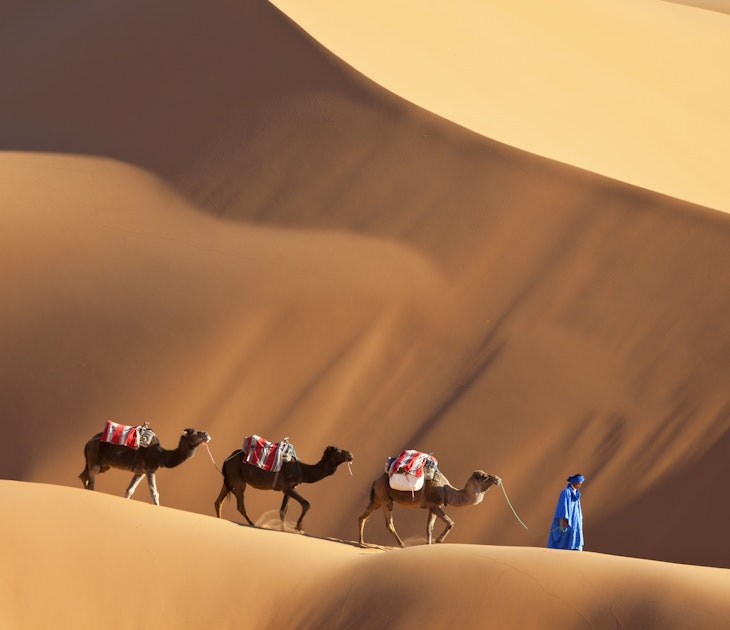
Festivals & Events
Mar 11, 2024 • 5 min read
Morocco is a fantastic year-round vacation destination, but the best time of year to travel will depend on your interests and holiday needs.

Feb 7, 2024 • 5 min read
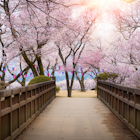
Jan 31, 2024 • 6 min read

Jan 27, 2024 • 15 min read

Jan 17, 2024 • 8 min read
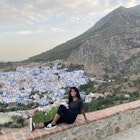
Jan 17, 2024 • 6 min read
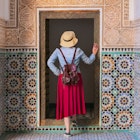
Nov 29, 2023 • 6 min read
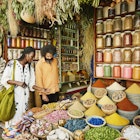
Nov 24, 2023 • 8 min read
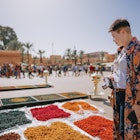
Nov 20, 2023 • 5 min read

Oct 11, 2023 • 7 min read

Morocco Travel Guide
Your ultimate morocco travel guide, with tips, things to do, and best things to see in morocco. great for first-time and returning travelers..
Morocco is a fascinating multicultural country blended from African, Arab and European influences.
It is our closest link to the continent of Africa and a diverse holiday destination.
The country offers an incredible amount of history, culture, art, and music along with a fascinating geographical landscape incorporating the Sahara desert, the snow-capped Atlas Mountains and the Atlantic coastline.
This Morocco trave l guide will help you plan your next vacation.
Popular Guides
- Moroccan Foods
- 5 Things to See in Morocco
Our Highlight
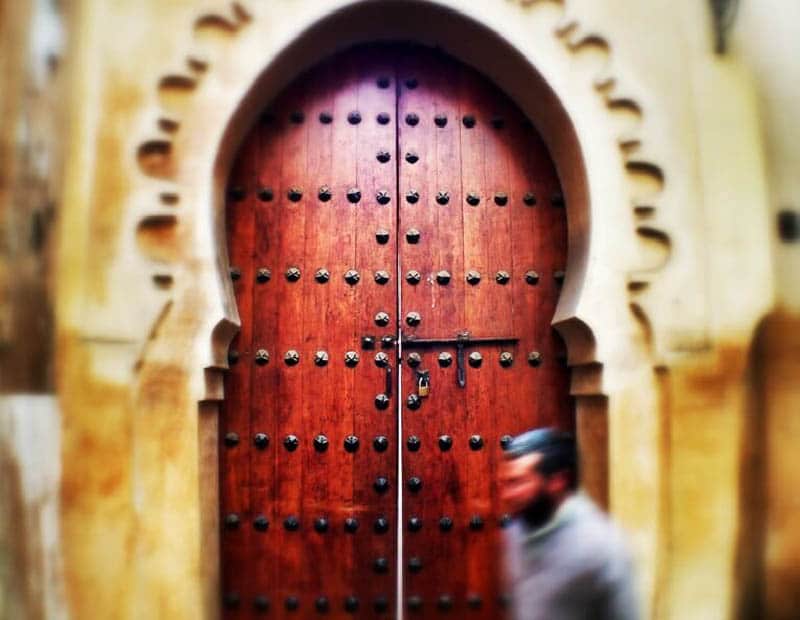
Table of contents
Table of Contents
Fast Facts about Morocco
- Moroccan power voltage is 127/220 V 60 Hz; Power sockets C & E
- The local currency is the Moroccan Dirham (MAD) and is around 9.50 MAD to 1 USD
- In the north of Morocco, visitors will find the Spanish enclaves of Ceuta and Melilla, claimed by Morocco and considered by the Moroccan state to be “occupied territory.”
- In these two towns, the main currency is the euro.
- Tipping is a way of life in Morocco; almost any service can warrant a tip so make sure to bring small bills.
- Haggling is also a way of life in Morocco.
- NEVER pay the asking price, vendors often double or even triple the prices of an item to allow some wiggle room through the haggling process.
- If you are not Muslim, you are not allowed in many of the mosques. Exceptions include the partially restored Almohad structure of Tin Mal in the High Atlas, the similarly disused Great Mosque at Smara in Western Sahara, the courtyard of the sanctuary-mosque of Moulay Ismail in Meknes and the Hassan II Mosque in Casablanca.
- Moroccan laws towards alcohol are quite liberal however drinking alcohol in public places is not recommended. During Ramandan, try to avoid drinking, eating or smoking in public during the hours of fasting.
- SIM Cards :
Things to See and Do in Morocco
- Enjoy a Four-Wheeling Adventure – join the guides of Dunes Desert Exploration and take a three hour tour in the desert on your very own dune buggy or quad bike.
- Surf’s up – Taghazout is a small fishing village 19 km north of the city of Agadir in the southwest of Morocco and houses some of the country’s best surf spots. It is nestled amongst a set of small bays just south of the legendary surf breaks of Anchor Point, Killers, and Mysteries.
- Go to a Hammam – A Hammam is a hot steam bath followed by a massage. Sounds simple enough doesn’t it? It definitely can be quite the experience!
- Visit Fes – Fes is the oldest city in the country and the Medina (or Fes el-Bali) is a World Heritage site. Fez is also famous for its leather products and most of it comes from the leather bazaar (souq). The souq is home to three ancient leather tanneries, the largest and oldest being the Chouara Tannery, which is almost a thousand years old.
- Take a cooking course – learn how to cook traditional Morrocans dishes from a gourmet chef while enjoying great conversations, appetizers and tea.
- Watch the sun rise on a Merzouga morning – to experience a desert sunrise is an unforgettable experience and the best place to do so is at the Merzouga sand dunes of Erg Chebbi
- Take in the colors of the Dades Gorge – There is nothing in the world quite like the Dades Valley. The mineral-rich Dades Gorge sparkles in many hues of blue and green as well as white and red.
- Spend a day in Jemaa el Fna in Marrakech – one of the main cultural spaces in Marrakech, this square has become one of the symbols of the city.
Morocco Travel Guides
- Top 5 Things You Must See in Morocco
- Things to Do in Marrakech – Practical Travel Tips and Where to Stay
- Etiquette in the Middle East- Travel for Men and Women
Accommodation
Budget: You can find a variety of hostels from 53-175 MAD per night. Enjoy dorms or private rooms, free breakfast, hot showers, and central locations to nearby tourist destinations. The Riad Verus in Fes even offers free Arabic classes.
Mid-Range: For mid-range, expect to pay around 380-860 MAD per night. These hotels come with a hotel restaurant and bar, rooms with flat-screen TVs and free Wi-Fi, a swimming pool, and room service.
High-End: For five-star hotels, you will pay around 860-4,100 MAD per night.Take in the best withspa services, fine dining, swimming pools with lounge areas, refined private suites with living rooms, a fitness center, and an airport shuttle.
Moroccan cuisine has a variety of influences, including Arabic, Berber, Mediterranean, and Andalusian cuisine, among others. Staples include fruits, vegetables, meat (beef, goat, lamb, and mutton), seafood, grapes, olive oil, and spices.
Couscous is a popular dish and is often served with meat or vegetables. Morocco also has a vibrant street food scene, where you can sample dishes like harira (a soup made from tomatoes, lentils, chickpeas, lamb, rice, and spices such as cinnamon) or merguez (minced beef or lamb sausages served in flatbread). There are sit-down restaurants as well where you can try more of Morocco’s cuisine. In total, expect to pay around 120 MAD per day for food. Read our full article 13 Delicious Moroccan Foods to Eat When Visiting Morocco
The Best Ways to Get Around Morocco
Getting to morocco:.
Flights: Morocco has 25 airports, but the main airport to fly into is the Mohammed V International Airport, located 15.5 miles from the city center of Casablanca. Another popular airport is Marrakesh Menara International Airport (4.6 miles from downtown Marrakesh), but the flights are mostly from Europe. You can check for the best flights to Morocco on Skyscanner .
Transportation:
Buses : Buses are good for traveling between cities. For more local trips between towns, expect to pay 3-5 MAD, or to go between cities, expect to pay between 210-340 MAD. A bus trip from Casablanca to Marrakesh, for example, will cost about 210 MAD.
Car Rental: To rent a car, you need to be at least 18-21 years old with a U.S. driver’s license that you have held for 1-2 years. Car rental prices start at 450 MAD per day for drivers 25 and older.
Taxis: Taxis are another way to get around. There are two types of taxis in Morocco: Petit and Grand. Petit taxis can seat up to 3 passengers, are metered, and only travel in the city, while Grand can seat up to and travel outside of a city. Grand taxis tend to have a fixed rate of 10.5 MAD for in-city travel.
Uber: Uber is not available at the time.
When to go To Morocco
For cheaper hotel rates and fewer crowds, visit Morocco during the shoulder seasons of April-May and September-November. The fall season in particular is a great time for hiking.
During the summer months of June-August, temperatures can get very hot, especially the closer you are to the Sahara, while winter months see more rainfall, which can dampen outdoor activities.
Where to Stay in Morocco
Hotel Moroccan House Casablanca : When in Casablanca, stay in this beautifully decorated hotel. Featuring traditional Moroccan-styled rooms, amenities include massage services, a restaurant, a hammam, and breakfast. For those who want to explore more of Casablanca, the tram station is just a 3-minute walk away.
Riad Rcif: Come stay in a restored 14 th -century palace at this unique hotel in Fes. Featuring colorfully decorated hotel rooms with artwork and glass-stained windows, the hotel also comes with a restaurant, a roof terrace with great views of the city, room service, and free breakfast. The Ibn Danan Synagogue is just 1.5 miles away.
ibis Marrakech Centre Gare Hotel: Just a short trip to Jemaa el-Fnaa square, Majorelle Garden, and the Koutoubia Mosque, this popular hotel in Marrakesh is a great place to stay. Swim in the outdoor pool while enjoying the surrounding gardens, watch TV in your hotel room, get drinks anytime at the 24-hour bar, order room service, or dine at the hotel restaurant.
Check out our favorite booking platforms Booking.com , Tripadvisor and VRBO for the best deals on accommodation.
What to Pack for Morocco
Morocco is about the size of France with coasts upon the Atlantic and the Mediterranean Sea and has an arid climate .
The coastal regions generally have a Mediterranean climate, however as travelers move further inland the conditions can become more extreme and elevation can play a role in the changeable weather conditions.
Morocco is also a Muslim country
- Modesty is respected and travellers are expected to follow the country’s etiquette. In villages and small towns, and even in the medinas of large cities, many women still wear the veil and the street is seen as strictly the man’s domain.
- Women travelers should avoid wearing revealing clothes, like short shorts, low cut shirts or thin-strapped blouses.
- Sarongs – I think we have sarongs in every packing list. From covering up when visiting mosques, being used as a towel or keeping cool on a hot night.
- Pack loose clothing with breathable fabric – cover up with fabric you know will breathe, especially if you plan on heading into the Sahara desert or to one of the coastal regions.
- Tunics are a great option as they can be dressed up or down, are lightweight and offer good coverage.
- Footwear – Pack a pair of lightweight, durable and comfortable shoes. Moroccan streets can be dusty and unclean so if you are uncomfortable with the idea of getting your little piggies dirty then opt for closed-toe shoes instead of sandals/flip flops.
- Kleenex / toilet paper – it is quite common that restaurant restrooms do not offer toilet paper to patrons, so make sure you are prepared.
- Also, don’t be surprised if you encounter squat toilets!
See our packing tips: packing list for smart travel
And see our Etiquette Tips for Travel to the Middle East
Morocco Travel Guide: Best Booking Resources
Whenever we travel to we make sure to start with these companies. We have tried a lot of different ones over the years and all of these have consistently proven to be the best when it comes to offering great prices.
We have used every one of these personally and continue to do so.
- Booking.com : This is our go site to when comparing prices for accommodation. It usually has the cheapest prices, especially in Europe and we love their interface. Not to mention you get free cancellation and you are guaranteed the best price.
- Trip Advisor : What we like about Trip Advisor is that we can look at all the reviews and then book our accommodation. TripAdvisor is where we go when we want to compare prices with multiple accommodation providers.
- VRBO : is the main search engine we use when we are looking for a home or apartment rental. It can sometimes be cheaper than hotels and it is the best way to stay in areas that offer a more local feel.
- Hostelworld : With one of the largest databases of hostels in the world, Hostelworld is the go-to site when you are looking for budget accommodation.
- Skyscanner : This is the first place we check for flights. It consistently comes back with the cheapest and best options. It allows us to compare a lot of airlines to get the best price.
- Rome 2 Rio : If you want to see how to get somewhere by plane, train, bus, ferry or car Rome2Rio lays it all out for you as well as related costs.I love how they show it all to you on a Google Map and it works offline.
- Get Your Guide: For all your day trip and city guide needs, we use Get Your Guide. It has the world’s largest collection of things to do with more than 30,000 activities in 7500 destinations.
- World Nomads Insurance: When traveling to Italy you should always have travel insurance. We have found the best bang for your buck is by far World Nomads.
Morocco Travel Guide: Related Articles
To browse all our articles and guides about Morocco click here.
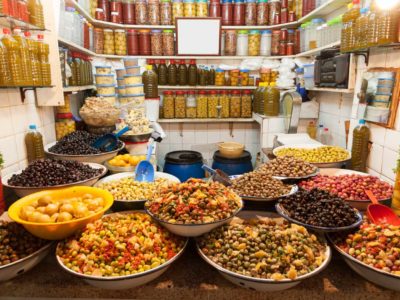
Traditional Moroccan Food to Eat in Morocco or At Home
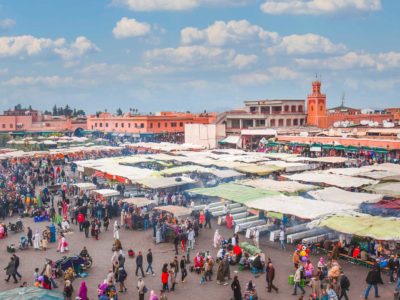
22 Best Things to Do in Marrakech, Morocco
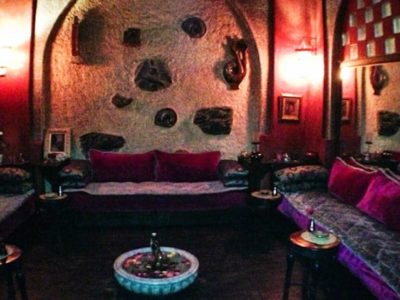
Hammam Spa Tips – Our Surreal Moroccan Massage Experience

The Ultimate Morocco Travel Guide
Are you ready for an adventure of a lifetime? Morocco awaits! With its bustling markets, stunning landscapes, and rich culture, it’s the perfect destination for the traveler seeking a unique experience. From camel rides in the Sahara to exploring ancient medinas, you’ll find something for everyone in this vibrant country. So pack your bags and get ready to explore all that Morocco has to offer – an unforgettable journey is just around the corner! You don’t have to break the bank to experience Morocco either. This cost-effective destination can be enjoyed on any budget. Whether you’re looking for luxurious resorts or affordable hostels, there are plenty of options available so you can tailor your trip exactly how you want it. And with its easy access from Europe and North America, getting there couldn’t be more convenient. So what are you waiting for? Start planning your trip to Morocco today with our travel guide!
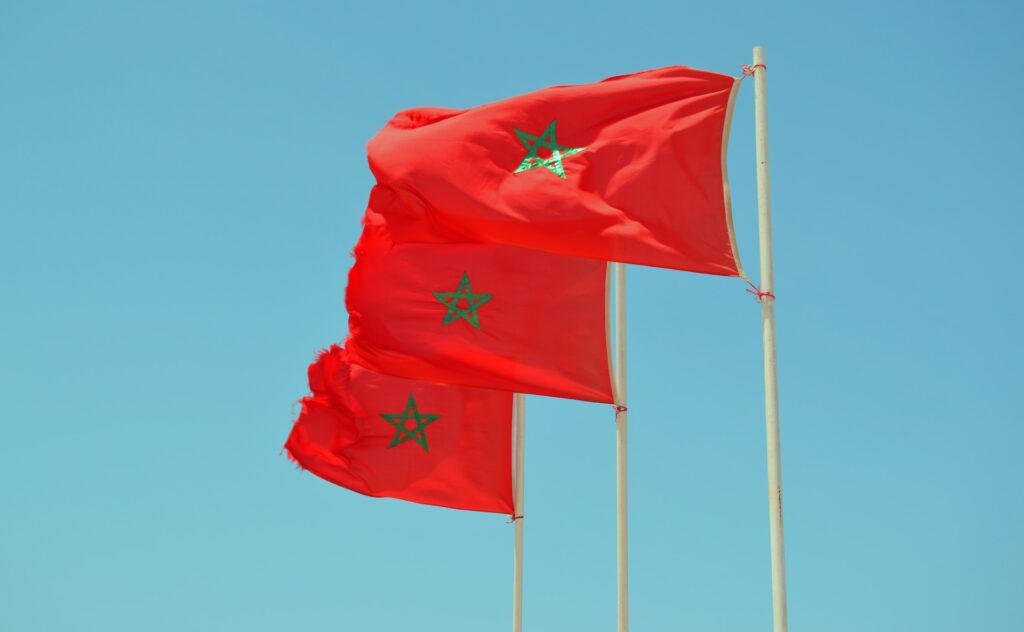
Introduction
Welcome to Morocco! This North African country is filled with breathtaking landscapes, rich culture, and centuries of history waiting to be explored. With its diverse geography ranging from snow-capped mountains in the High Atlas range to stunning deserts along the Atlantic coast, you can expect a variety of climates throughout the year. And as for culture, Morocco is bursting with vibrant music, delicious food, and traditional art that will give you an unforgettable experience. So let’s dive into this incredible country and take a closer look at its past and present.
From its rugged mountains to its vast deserts, Morocco’s geography is full of wonders waiting to be explored! This country is situated in the North African region and has a total area of 446,550 square kilometers. It is bordered by Algeria, Mauritania, and Western Sahara as well as the Mediterranean Sea and the Atlantic Ocean. In terms of physiographic regions, Morocco has an immense mountain range called the Rif Mountains which stretch from the north to the northeast of this country.
The Atlas Mountains are located in central Morocco and form a southward arch towards the southwest. The Middle Atlas range lies between these two major ranges while further south is the Anti-Atlas and High Atlas Mountains which form part of the Saharan region. In terms of lowlands, there are three main basins in Morocco namely the Souss-Massa Basin in the southwestern region; El Jadida Basin along the Atlantic coast; Ouergha basin near Al Hoceima city. With such diverse topography, it’s no wonder that visitors can experience a wide variety of climates throughout their trip!
Experience the diverse climates of Morocco, from its hot deserts to its cool mountaintops! From the Mediterranean coast in the north to the Atlantic Coast in the west, and from the Sahara Desert in the south to its rolling hills and lush valleys, Morocco’s climate offers something for everyone. Here are three ways you can take full advantage:
- Visit coastal towns like Rabat or Casablanca for a temperate climate with mild winters and warm summers.
- Head into the Atlas Mountains for cooler temperatures year-round, with snow cover during winter months.
- Explore southeastern Morocco’s deserts for an experience unlike any other – hot days and cold nights!
- No matter what type of climate you’re looking for, there is something special waiting for you in Morocco – so come explore it all! With such varied conditions across this beautiful country, the culture here is as diverse as its landscapes – so let’s dive into that now.
Discover the incredible culture of Morocco, from its ancient Berber traditions to its vibrant street life! Whether you’re in a bustling city or a small village, you’ll get an immersive experience. Moroccan culture is steeped in tradition and history, with strong influence from the French colonization. You can see this reflected in everything from their dress to their food. For example, couscous and tajine are popular national dishes that have been passed down for generations.
Take some time to explore the fascinating architecture of Morocco’s cities too—marvel at the intricate designs of mosques and madrasas (Islamic schools). And don’t forget to immerse yourself in the lively atmosphere of local markets—you’ll be sure to find something special here. From traditional music and art to language and cuisine, there’s so much that makes Moroccan culture unique. Transitioning now into a discussion about ‘History’, it’s clear that Morocco has always been a place where different cultures have collided – leaving behind an amazing blend of customs and beliefs.
Dating back centuries, Morocco has been at the crossroads of various empires and civilizations, resulting in a rich history filled with stories of conquest, trade, and religious growth. From the ancient Roman Empire to the Islamic dynasties that followed, Morocco’s history is full of fascinating tales that bring visitors from all around the world. The country has also played an important role in global events such as World War II and its aftermath. With each passing era, Morocco has been shaped by different cultures and beliefs, making it a truly unique destination to explore.
As you learn more about its past, you’ll find yourself captivated by its diverse heritage. From archaeological sites to traditional villages, there are many ways to experience Moroccan history firsthand. And no matter where you go or what time period you choose to visit, you’re sure to be inspired by this amazing country’s deep-rooted culture and traditions. So now that you know about the historical background of this wonderful land – when’s the best time for your next adventure?
Deciding when to visit Morocco can be tricky. The best time to go is typically spring or fall for mild temperatures and fewer crowds, although it’s still quite popular during these months. On the flip side, summertime can be oppressively hot and winter cold at night, making them the worst times to take a trip. No matter where you go, you’ll find plenty of adventure and culture in this vibrant country!
Best time to visit
When planning your trip to Morocco, consider when you want to visit; the time of year can make a big difference in your experience. Generally speaking, the best time to visit Morocco is in spring and fall. During these seasons temperatures are mild, which makes exploring the country significantly more pleasant than during summer’s scorching heat or winter’s chilly winds.
In spring (March-May), days are mostly sunny with occasional rain showers that bring life to the desert landscape and blooming flowers to gardens. This season also coincides with cultural festivals such as the International Film Festival of Marrakech and the Timitar Festival of Gnawa Music , providing ample entertainment options for travelers. Fall (September-November) brings an even more vibrant atmosphere due to its harvest season when locals celebrate their crops with festivities. The air is fresh and temperatures range from cool at night to enjoy warmth during day hours.
No matter what time of year you choose, there’s always something unique waiting for you in Morocco; jump into this fascinating culture and let it show you its wild beauty!
The worst time to visit
However, it’s also important to know the worst time to visit Morocco. The summer months of July and August are usually the hottest and driest, with temperatures soaring into the triple digits. This can make sightseeing and outdoor activities difficult. Similarly, winter can be cold and wet in many parts of Morocco as well, making travel more difficult during this season. Therefore, if you’re looking to explore all that this beautiful country has to offer without too much heat or rain interference, spring, and fall are generally the best times for a visit.
Where to Go
If you’re looking for an unforgettable travel experience, then Morocco is the place for you! With a wealth of unique cities to explore, it can be hard to know where to start; however, Marrakech, Fez , Meknes, Chefchaouen , and Essaouira are among the top destinations in the country. Each city offers something different – Marrakech has vibrant souks and markets full of local products; Fez is steeped in ancient history and culture; Meknes is known for its grand gates and palaces; Chefchaouen has charming blue-washed buildings; while Essaouira has a laid-back atmosphere with plenty of beaches.
Marrakech is a city of vibrant colors and culture – an absolute must-see during your trip to Morocco! As you explore the souks, visit the medina, and take in all the sights and sounds of this ancient city, you’ll be captivated by its incredible energy. Here, you can find anything from traditional Moroccan carpets and ceramics to handcrafted jewelry. The smells of spices will fill the air as merchants try to entice you with their wares. Be sure to try some of the local delicacies like tajines or couscous while visiting; these dishes are made with fresh ingredients that will linger on your taste buds long after you’ve left Marrakech. From sunup to sundown, there’s something for everyone in this city – no matter what it is that ignites your wanderlust spirit!
The hustle and bustle of Marrakech will leave you feeling energized yet ready for a change of pace. Thankfully, Fez is just a short drive away! With its narrow alleyways lined with traditional shops, cafes, and workshops selling everything from leather goods to pottery pieces – it’s easy to get lost in this enchanting city. The old town has been declared a UNESCO World Heritage Site due to its incredible architecture which includes numerous palaces, mosques, and madrasas each filled with fascinating history. Exploring these historical sites surrounded by lively markets will give you an insight into traditional Moroccan life that cannot be found anywhere else – so don’t miss out on this unique experience!
Fez is an enchanting city full of history and charm that beckons your exploratory spirit! The city has long been a center for culture, art, and learning with its ancient medina – the world’s largest car-free urban area. With narrow cobbled streets lined with vibrant merchants selling goods from spices to rugs , Fez is sure to captivate even the most experienced traveler. Exploring this city will take you back in time and give you a chance to experience what life was like centuries ago.
From the bustling souks (markets) of the old Medina to the stunning architecture of its mosques and palaces, Fez is a place where travelers can immerse themselves in Moroccan culture. For those looking for a taste of modern-day charm, head over to Ville Nouvelle – an area built by French occupiers in 1912 filled with chic cafes and restaurants offering delicious local cuisine. No matter how you explore it, Fez will leave you feeling charmed by its beauty and inspired by its rich history! Onward now to Meknes – another one of Morocco’s imperial cities!
Meknes is a stunning imperial city that’ll delight your senses with its vibrant culture and architecture! It’s one of the original four imperial cities in Morocco , and it was once the capital of the country. The city has an impressive walled medina, lined with bazaars and ancient sites. Meknes is also home to some beautiful gardens, and there are several palaces throughout the area as well. The architecture is quite unique, mixing traditional Moroccan style with Spanish influence from when Spain occupied part of Morocco.
Visiting Meknes can be a very rewarding experience for those who want to take in all that this gorgeous city has to offer. From exploring its winding alleyways to admiring its grand monuments, you won’t want to miss out on all that this incredible destination offers. With so much history and culture around every corner, Meknes will captivate you from start to finish. Exploring this amazing city will surely give you an unforgettable Moroccan adventure!
From marveling at Meknes’ stunning sights to taking in its rich history, it’s time now for another journey: heading north towards Chefchaouen!
Chefchaouen
Take a journey to the blue-washed streets of Chefchaouen , a unique Moroccan city that’ll captivate you with its stunning beauty and relaxed atmosphere. This city is known for its well-preserved medina, or old town, which has been painted in shades of blue for centuries. Whether you’re exploring the narrow cobblestone streets lined with artisan shops and cafes, admiring the beautiful mosques tucked away in secret alleys, or simply watching locals go about their daily routines from one of the many rooftop terraces, there’s no shortage of fascinating things to do here. The laid-back vibe makes Chefchaouen an ideal place to spend some time exploring and soaking up the culture. With all it has to offer, this charming little city is sure to leave you wanting more. To discover yet another charm of Morocco’s cities head over to Essaouira next.
Surrounded by miles of undisturbed beaches and fortified by towering city walls, Essaouira is a captivating port town with plenty of unique attractions. Enjoy the sights and sounds of an authentic Moroccan fishing village as you explore awe-inspiring Old Town streets. Take in stunning views from the top of the ancient ramparts, or wander through bustling bazaars to discover handmade crafts, carpets, and artwork. Unwind on one of the pristine beaches while savoring fresh seafood dishes prepared daily by local fishermen. Relaxed vibes and a slower pace make it easy to lose track of time in Essaouira—you won’t want to leave! Next up on your Morocco adventure is Ouarzazate, a vibrant desert oasis known for its impressive film sets and historic Kasbahs.
From the coastal town of Essaouira, take a road trip south to Ouarzazate in the Saharan Desert. Nestled between stark red mountains and rolling desert sands, this city is an oasis for travelers looking for adventure. Here is a list of must-dos when visiting Ouarzazate:
- Visit Taourirt Kasbah – This impressive kasbah was once the home of the Glaoui family and has been featured in many films since then. Enjoy exploring its maze-like corridors and discovering hidden courtyards filled with vibrant colors.
- Take a camel ride through the dunes – Get up close and personal with the desert landscape while riding atop a majestic camel on a tour through Erg Chebbi or Merzouga Sand Dunes near Ouarzazate.
- Visit Ait Benhaddou – This UNESCO World Heritage Site is one of Morocco’s most famous cities and boasts mud-brick homes, towering kasbahs, and stunning views of the surrounding mountainside. Don’t forget to stop at Café des Sables for lunch!
- Climb Jebel Sargho – Get your heart pumping as you summit Jebel Sargho, one of Morocco’s highest peaks located just outside city limits where you can take in breathtaking views from the top.
Ouarzazate offers something unique to every traveler who visits its beautiful desert landscape – now it’s time to explore even further into the Sahara Desert!
Sahara Desert
The Sahara Desert is a vast expanse of dunes and valleys that will take your breath away. With its golden sand, the desert stretches far in every direction, offering an unparalleled view of serenity and splendor. Soak up the sun’s rays as you trek through ancient pathways and explore the stunning landscape. Experience true tranquility as you watch the sunset against the horizon – it’s an unforgettable experience!
Discover a world unlike any other as you explore the mighty Sahara Desert. Whether you choose to hike to a picturesque oasis or cruise across sand dunes in a four-wheel drive, an adventure awaits in this majestic place. And for those looking for even more thrills, why not try camel riding or sandboarding? No matter what type of journey you embark on, one thing is certain: The Sahara Desert won’t disappoint. From here, take your next steps toward exploring the High Atlas Mountains!
High Atlas Mountains
Experience the raw beauty of the High Atlas Mountains as you explore its rugged terrain. With towering peaks reaching up to 13,671 feet in height, this mountain range is the highest in North Africa and provides a stunning backdrop for any adventure. From skiing and snowboarding during winter months to trekking and mountaineering in summer, there is no shortage of outdoor activities available year-round. Whether you’re looking for an adrenaline rush or simply want to take in the majestic views, a visit to the High Atlas Mountains will provide an unforgettable experience.
The High Atlas Mountains also offer numerous cultural attractions that are sure to captivate visitors from around the world. Visit small Berber villages and learn about their rich history while sampling traditional dishes like couscous or tajine. Explore colorful markets where you can find unique souvenirs or barter with locals over goods like handmade rugs and pottery. As you journey through this breathtaking landscape, take time to appreciate its culture and customs – it’s an experience unlike any other! With so much to see and do within these majestic mountains, your Moroccan vacation is sure to be one for the books. Next up: explore Morocco’s Mediterranean coast!
Mediterranean coast
Discover the stunning beauty of Morocco’s Mediterranean coast, with its picturesque beaches and vibrant coastal towns. From the cosmopolitan city of Tangier to the historic Agadir fishing port, there is something for everyone along this stretch of coastline. The crystal clear waters, golden sand beaches , and lush vegetation make it a paradise for sun-seekers, beach lovers, and outdoor adventurers alike. Whether you’re looking for an action-packed holiday or just want to relax in style, Morocco’s Mediterranean coast has plenty to offer.
Take in a captivating sunset on the terrace of one of the many charming cafés that line the waterfront promenades or explore a traditional Berber village nestled among rugged hillsides covered in wildflowers. Adventure seekers can try their hand at sailing, surfing, or kitesurfing; while those who prefer to stay on land can go hiking through cedar forests or take a guided jeep tour across sand dunes. With so much to see and do, Morocco’s Mediterranean coast provides an unforgettable experience no matter what kind of traveler you are! Moving on from here, next up we’ll discuss what else is available for travelers along this beautiful stretch of coastline.
Experience the best of Morocco by exploring its bustling souks, going on a thrilling hike, and spending some time at the beach. Learn about Moroccan culture by soaking up local traditions and sampling the delicious food. All this and more await you in this beautiful destination – so come explore it today!
Explore the souks
Head to the souks and you’ll find yourself in a bustling, vibrant atmosphere filled with sights, sounds, and smells. Wander through the winding alleyways of Morocco’s traditional marketplaces and you’ll have something to please every sense. From hand-crafted rugs and jewelry to exotic spices and leather goods, these bazaars offer an array of unique treasures from all around the world. The hustle and bustle will transport you away from your everyday life as bartering ensues between merchants selling their wares. Make sure to take some time out for a cup of mint tea with locals who are more than happy to share their stories with travelers – it’s an experience not easily forgotten! With plenty of cultures, history, food, music, art, and color around every corner, exploring Morocco’s souks is truly a magical experience that will leave lasting memories. Get ready for some outdoor adventure because next up is going hiking!
Put on your hiking boots and come explore the great outdoors of Morocco! From the majestic Atlas Mountains to the bustling coastal towns, there’s something for everyone in this stunning country. Stroll through lush valleys dotted with olive groves and citrus orchards, and take in breathtaking views of winding rivers and rolling hills. Soak in some sun as you traverse ancient trails lined with wildflowers. As you journey further into the wilderness, you’ll be rewarded with a rich cultural experience full of friendly locals who are happy to share their stories with travelers. Get ready for an unforgettable adventure that will take your breath away!
Whether it’s a leisurely stroll or a challenging trek, hiking is one of the best ways to discover all that Morocco has to offer:
- Enjoy unique wildlife sightings such as Barbary macaques, gazelles, eagles, lizards, and more.
- Take part in traditional activities like herding goats or picking fruit from nearby farms.
- Visit centuries-old Berber villages hidden in remote mountain locations.
These are just a few of the outdoor experiences waiting for you – so put on your hiking boots and get ready for an adventure! With its diverse landscapes and welcoming locals, Morocco offers an unparalleled opportunity to explore nature at its finest. So go ahead – immerse yourself in this spectacular land of beauty and culture; you won’t regret it! Now it’s time to head to the beach – prepare yourself for even more fun in the sun!
Spend time at the beach
Come to Morocco for a one-of-a-kind beach experience! With its stunning Mediterranean and Atlantic coastlines, you can bask in the sun while exploring tranquil coves, relax on white sand beaches, or take a dip in crystal-clear waters. Whether you’re looking for an adventure or just want to chill out with friends, you’ll find plenty of exciting activities in this paradise by the sea. From water sports and sunset cruises to exploring traditional fishing villages and exotic markets, there’s something for everyone at the beach. So slip away from reality and let your worries melt away as you soak up some sun in this beautiful country. Take advantage of all that Morocco has to offer – it’s a truly unique experience that you won’t soon forget!
Ready for something even more special? Ditch the crowds and learn about Moroccan culture – a whole new world awaits.
Learn about Moroccan culture
Experience the captivating culture of Morocco and immerse yourself in its unique traditions! From learning about traditional handicrafts to exploring local markets and experiencing a bustling medina, there are plenty of ways to explore Moroccan culture. Here are some tips on how you can get a taste of what makes this country so special:
- Visit an authentically designed riad – These traditional homes feature intricate tile work, cozy courtyards, and elaborate decorations that make them perfect for lounging or entertaining guests.
- Take in a show at the Djemaa el Fna – This famous city square has been the center of Marrakech’s nightlife for centuries. Every evening, it is filled with musicians, food stalls, snake charmers, and more.
- Attend a cooking class – Learn how to prepare flavorful tagines using local ingredients while getting an inside look into Moroccan cuisine .
- Experience an authentic hammam – Hammams are public baths that have been used by locals since ancient times as places to socialize and relax. Enjoy steamy saunas followed by a refreshing massage with natural oils and salts.
By taking part in these activities, you’ll be able to truly appreciate all the unique aspects of Morocco’s culture. And after getting your cultural fix, why not sample some of the delicious local dishes?
Sample the Moroccan food
Sink your teeth into Morocco’s flavorful cuisine and savor every bite! From traditional tagines to couscous, Moroccan food has something for everyone. The country’s famous national dish is a fragrant stew cooked in an earthenware pot called a tagine. This often includes vegetables, meats, and spices like saffron or cumin. Couscous is another favorite which consists of steamed semolina grains served with veggies or meat. Street vendors are known for their delicious crepes filled with beef or chicken, olives, tomatoes, and onions – they’re the perfect snack on the go! Delicate pastry desserts such as baklava and chakra are also popular and make great gifts to bring home from your trip. Taste the rich flavors of Morocco – you won’t be sorry!
From exploring the medinas to camel rides in the Sahara Desert, getting around Morocco offers endless possibilities for adventure.
Getting Around
Getting around Morocco is a breeze. You can travel by plane, train, bus, taxi, or grand taxi – all giving you the opportunity to explore the country’s beautiful landscapes and vibrant culture. Whichever method of travel you choose, it’ll be an easy and convenient way to get where you need to go.
Flying to Morocco is easy and affordable, with plenty of direct flights from the US and Europe. You can choose to fly into one of the four main international airports in Casablanca, Marrakech, Agadir, or Tangier. From there, you have a few options for getting around: trains, buses, and taxis. Flying is a great way to get around quickly and easily:
- Choose your destination city – Casablanca has bustling markets while Marrakech offers more cultural sights like the Jemaa El-Fnaa Square .
- Arrange your flight – look for low-cost carriers like Ryanair or check out online travel agencies like Expedia or Travelocity for deals on major airlines such as Air France or British Airways.
- Book your tickets – make sure you’re aware of any visa requirements before booking your tickets!
Flying is an efficient way to explore Morocco; it’s quick and convenient so you can maximize your time in this amazing country! Plus, if you plan ahead there are usually good deals available on flights from all over the world so you can save some money too. Now that you know about flying in Morocco, let’s take a look at how to get around by train…
Taking the train is a great way to explore Morocco and get around in comfort. With high-speed rail lines connecting all major cities, you can traverse the country with ease. Travelers also have access to overnight trains for longer trips, winding through stunning vistas and providing both an incredible view of Morocco and a comfortable way to cover long distances without having to stay in hotels or break up travel plans.
The ticketing system is straightforward and offers travelers discounts on certain routes while reducing prices for children under 12 years old. You can purchase tickets online or directly at the station – reservations are recommended but not always necessary depending on your destination. Plus, many trains offer free Wi-Fi onboard so you can stay connected during your journey! All in all, traveling by train is an ideal way to experience Morocco’s beauty while still being able to relax and enjoy the ride.
With that said, bus travel may be a better option if you’re looking for something more cost-effective or if you plan on making lots of stops along your route.
Exploring Morocco by bus provides an economical way to get around while taking in the sights, sounds, and culture of the country. Advantages of traveling by bus include:
- The ability to observe locals going about their daily lives
- The opportunity to experience different flavors of Morocco’s beautiful scenery
- A chance to meet fellow travelers from all over the world.
Taking a bus ride across Morocco is a great way to explore its diverse landscape and dive into its multicultural society. Plus, you can avoid spending money on accommodation as some routes take you overnight! Ready for your next adventure? Let’s hop aboard a taxi and go!
Hop in a taxi and feel the wind on your face as you explore Morocco in a whole new way! Taxis offer an easy, convenient way to get around the country. Whether you’re traveling from city to city or just need to cover a few blocks, taxis are affordable and often more comfortable than riding in a bus. You can take local petit taxis (small cars) for short trips within cities, or grand taxis (larger vehicles that usually seat six people) for longer trips between cities.
It’s important to note that grand taxis don’t operate like normal cabs—they only leave when they’re full of passengers, so be prepared to have some extra time added onto your journey if there aren’t enough passengers ready at once. Negotiating fares is common practice and should always be done before getting into any type of taxi. With that being said, hopping in one of these cozy little cars with locals is sure to make your Moroccan adventure even more memorable! Onward now – let’s explore grand taxis next!
By grand taxi
Grand taxis are a great way to get around Morocco for longer trips between cities – they’re comfortable and can take you to your destination in no time! While the cost of these taxis may be slightly higher than other methods of transport, it is often worth the convenience. Grand taxis are typically shared by multiple passengers going in the same direction, which means that you will have an opportunity to meet locals and hear stories about their lives. Plus, you won’t need to worry about navigating or waiting in long lines for public transportation. Traveling by grand taxi is a great way to explore Morocco while still getting where you need to go quickly and efficiently.
The best thing about traveling by grand taxi is that several providers offer fixed fares for certain routes, so you can plan out your journey ahead of time without having any surprises when it comes time to pay. Just make sure that all parties agree on the price before you set off, as this ensures everyone is on the same page when it comes time for payment. With that said, let’s move on to some tips for traveling to Morocco!
Tips for Traveling to Morocco
If you’re planning a trip to Morocco, there are some important tips to keep in mind. Learn some basic Arabic phrases so you can communicate with locals, be respectful of Moroccan culture and customs, bargain at the souks for souvenirs, always drink bottled water, and pack light. With these tips in mind, your time in Morocco is sure to be memorable.
Learn some basic Arabic phrases
Greeting locals in Arabic is a great way to make your Moroccan travel experience even more enjoyable – so let’s get started! Learning some basic phrases, such as “hello” and “thank you” will go a long way in helping you connect with the local culture. You may not be able to learn enough of the language to have full conversations, but knowing simple phrases can make all the difference when it comes to being respectful. For example, saying “as-salamu alaykum,”which means “peace be upon you,”is an appropriate greeting that shows respect for locals. Additionally, learning phrases like “shukran,”which means thank you, allows you to express gratitude in a meaningful way. Taking the time to learn these few words of Arabic could really enhance your travel experience and make it much more memorable. Moving forward then into being respectful of Moroccan culture…
Be respectful of Moroccan culture
Immersing yourself in the culture of Morocco can be an incredibly rewarding experience – but it’s important to remember to always show respect. Here are a few key cultural expectations to keep in mind:
- Dress modestly – especially when visiting mosques and holy sites. This means avoiding short shorts, tank tops, and low-cut shirts.
- When visiting rural areas, always dress conservatively for women. Covering your shoulders will help you avoid unwanted attention from locals.
- Respect religious customs – specifically non-Muslim customs such as Ramadan fasting or Islamic prayers. Refrain from eating, drinking, smoking, or making loud noises during these periods of worship.
- Be mindful of local customs – this includes being aware of how much physical contact is acceptable between men and women in public spaces (it’s not recommended). Additionally, it is considered polite to remove shoes before entering someone’s home or a mosque.
Being mindful of these cultural nuances while traveling can ensure that your experience is both respectful and enjoyable! Transitioning into the next section about bargaining in the souks should come easy after being mindful of cultural norms – it’s time to get shopping!
Bargain in the souks
Shopping in the souks of Morocco can be a thrilling experience – but don’t forget to bargain for the best price! You’ll find amazing items like leather goods, spices, carpets, jewelry, and clothing. Don’t just accept the first offer given to you; it’s expected that you will barter with shopkeepers for a better price. It’s important to stay polite and friendly while bargaining, as this is an essential part of Moroccan culture. And while haggling is part of the fun, make sure not to be disrespectful or come off too aggressive; it won’t get you anywhere. When you’ve reached a deal that works for both parties, relish in your victory as you walk away with a great souvenir at a great price. Next up: drinking bottled water!
Drink bottled water
When visiting Morocco, make sure to always drink bottled water – it’s the safest way to stay hydrated! Bottled water is widely available throughout the country at stores, restaurants, and street vendors. It’s also common knowledge that taps water in Morocco is not safe for drinking due to high levels of bacteria and other contaminants.
Drinking bottled water has many benefits: it can prevent gastrointestinal issues; it helps keep you cool in hot climates; and most importantly, it allows you to enjoy all the amazing sights and sounds of Morocco worry-free! With that said, packing light – including a reusable bottle for refills – will ensure you have enough space for souvenirs and mementos from your trip.
Pack light and bring a reusable bottle so you can enjoy your trip without worrying about packing too many souvenirs. There’s no need to overpack for Morocco – just bring the basics! A few changes of clothes, some comfortable shoes, and toiletries should suffice for most trips. Bring a lightweight backpack or day bag to carry all your essentials easily. This will help you move around without feeling weighed down by excess baggage. Plus, it’ll be easier to explore different parts of the country without having to worry about lugging heavy bags around with you. With just the right amount of items packed in a lightweight bag, you’ll be ready to get out there and start exploring Morocco!
By packing light and bringing only what you need for your trip, not only will it save time at check-in but it will also save money on extra baggage fees from airlines. And when it comes time to head home, you won’t have to worry about paying additional fees for overweight luggage or having to purchase extra boxes for souvenirs – leaving more room in your budget for other experiences while traveling! So remember: pack light and leave plenty of space in your suitcase (or backpack) for all the wonderful memories that await during your Moroccan adventure.
Are you looking to plan a trip to Morocco but have no idea what it may cost? Well, you’ve come to the right place! We’re here to break down the average costs of a trip so that you can plan your vacation without worrying about breaking the bank. So let’s take a look at how much it will cost for you to travel to Morocco!
How much does it cost to travel to Morocco?
Planning a trip to Morocco doesn’t have to break the bank – with careful budgeting, you can explore this vibrant country without blowing your budget. Prices for food and basic items like toothpaste or shampoo are quite reasonable in most parts of Morocco so your biggest expense will likely be accommodation. Depending on the type of accommodation you choose, prices can range from budget-friendly hostels to luxury 5-star resorts. If you plan ahead and book early, you can often find good deals on flights and hotels that won’t drain your wallet. With a bit of research and careful planning, it’s possible to enjoy a trip to Morocco without breaking the bank! And when it comes time to find a place to stay during your visit, there are plenty of great options available.
Accommodation
If you’re looking for somewhere to stay in Morocco, you’ve got plenty of options. From hostels and hotels to camping, there are accommodations that fit every budget, so don’t worry about not finding something suitable. You can also choose from traditional Moroccan riads or kasbahs if you want a more authentic experience.
Where to Stay in Morocco
No matter what kind of vacation you’re looking for, Morocco has a stay option that’s perfect for you! From rustic camping and caravanning to luxury all-inclusive resorts, there are plenty of places to rest your head during your visit. Whether your goal is a relaxing getaway or an adventure in the great outdoors, there’s something for everyone.
If you’re more into the local vibe, you can find traditional Moroccan riads with rooftop terraces and ornate courtyards — perfect for experiencing the culture up close. And no matter where you stay, stunning views of deserts, mountains, and oases are sure to make it memorable. When it comes to accommodation in Morocco, the possibilities are truly endless. Now let’s move on to visas and currency when traveling in this exciting country!
Visas and Currency
If you are planning a trip to Morocco, it’s important to know what kind of visa you need and what currency is used. To make things easier, here’s a quick rundown of visas and currency in Morocco so you can plan your trip without any hassle. You’ll need to apply for a tourist visa before traveling, and the local currency is the Moroccan Dirham . Make sure you familiarize yourself with exchange rates and plan accordingly!
What do I need to know about visas and currency in Morocco?
You’ll need to familiarize yourself with both the visa requirements and currency exchange when planning a trip to Morocco. * Make sure you have an up-to-date passport that is valid for at least 6 months beyond your travel dates.
- Find out if you need a visa in advance or if you can obtain one upon arrival in Morocco.
- Research the currency before you go to avoid surprises when exchanging money.
- Compare exchange rates offered by banks, kiosks, and other money changers for better deals.
- Familiarize yourself with local customs to ensure a more enjoyable experience in Morocco.
Visas and currency are just two of the details involved in planning a trip to Morocco, but they should be taken seriously before traveling so you don’t run into any problems or delays during your vacation. With some preparation and research beforehand, getting help from locals once you arrive should be smooth sailing!
Getting help
If you find yourself in need of help while traveling in Morocco, don’t worry. You can get some assistance from the local people, who are friendly and willing to lend a helping hand. If you’re lost or have any other issues, try asking one of the locals for help. Additionally, if you’re looking for more specialized assistance, there are many tour guides available who can provide valuable information and guidance throughout your trip.
What if I need help while I’m in Morocco?
You can always find assistance if you need it while in Morocco; the locals are more than happy to help. Whether it’s directions, recommendations, or simply a friendly face, there is no shortage of people eager to lend a hand. You may even find that your hostel staff or hotel concierge will be able to provide invaluable information and advice about the area. Or perhaps you just need someone to chat with – many locals love talking about their culture and country so don’t hesitate to strike up a conversation! Additionally, many cities have tourist offices which can often provide valuable resources for travelers looking for help navigating their way around Morocco. Whatever your needs, don’t be afraid to ask for help – you’ll likely find plenty of friendly faces willing and able to assist you during your travels in Morocco!
You’ve now got all the info you need to get started planning your trip to Morocco with our travel guide! With its stunning beaches, unique culture, and world-class attractions, there’s something in this country for everyone. Whether you’re an experienced traveler or a first-timer, you won’t regret making the journey. Make sure to budget accordingly and plan ahead so that you can make the most of your time in Morocco. Don’t forget to try some of their delicious local cuisines while you’re there! So what are you waiting for? Start packing and get ready for an unforgettable experience!
Book the best Morocco all-inclusive tours!
Marrakech tours.
- 2 days tour from Marrakech to Zagora
- 3 days tour from Marrakech to Merzouga desert
- 3 days tour from Marrakech to Fes
- 4 days tour from Marrakech to Merzouga desert
- 5 days tour from Marrakech to Merzouga desert
- 5 days tour from Marrakech to Fes
- 4 days tour from Marrakech to Fes
- 6 days tour from Marrakech to Merzouga desert
- 7 days tour from Marrakech to Fes
- 8 days tour from Marrakech to Fes
- 12 days tour from Marrakech
Tangier tours
- 2 days tour from Tangier to Chefchaouen
- 5 days tour from Tangier to Marrakech
- Morocco 1 week itinerary from Tangier
- 9 days tour from Tangier to Marrakech
Agadir tours
- 7 days tour from Agadir to Merzouga desert
- 5 days tour from Agadir to Merzouga
- Agadir to Merzouga desert tour – 4 days
Casablanca tours
- 4 days tour from Casablanca to Marrakech
- 5 days tour from Casablanca
- 6 days tour in Morocco from Casablanca
- 7 days tour in Morocco from Casablanca
- 8 days tour in Morocco from Casablanca
- 9 days tour from Casablanca
- 10 days tour from Casablanca
- 12 days tour from Casablanca
- Morocco 2 week itinerary from Casablanca
- 2 days Sahara desert tour from Fes to Merzouga
- Fes to Chefchaouen tour in 2 days
- 4 days tour from Fes to Marrakech
- 3 days Fes to Marrakech desert tour
- 3 days tour from Fes to Merzouga desert
- 5 days tour from Fes to Marrakech
- 6 days tour from Fes to Marrakech
Travel to Morocco: A Complete Guide (Tips + Morocco Itinerary).
- By Sarah Steiner
- Updated On March 18, 2024
Welcome to our Morocco Travel Guide! It’s safe to say we love Morocco. It’s March 2024 and we are just wrapping up SIX months of travel to Morocco.
We arrived by ferry from Spain and have hugged and surfed the beautiful Atlantic coastline. We loved the contrast of the famous imperial cities (Fes, Marrakech, Chefchaouen) and desert towns (Ouarzazate, Merzouga and Zagora) heading all the way inland to the Sahara Desert. And we ventured way down south to camel markets (Guelmim), historic settlements (Sidi Ifni) and surfing hotspots (Taghazout, Tamraght and Dakhla).
So now; after six incredible months of travel to Morocco here is our complete Morocco Travel Guide and itinerary with everything you need to know for an epic trip to Morocco of your own!
In this Morocco travel guide you will find:
- Travel to Morocco
- Best time to visit
- Traveling to Morocco
- Data, WIFI and connectivity
- Safety in Morocco
- Money and ATM’s
- Food and alcohol
- Transportation within Morocco
- Morocco itinerary
- Places to visit in Morocco – Tangier – Chefchaouen – Fes – Rabat – Casablanca – Essaouira – Marrakech – Agadir – Merzouga – Ouarzazate – Ait Ben Haddou
- Accommodation in Morocco
- More about travel to Morocco
About Morocco, just quickly
- Full Name: The Kingdom of Morocco
- Capital: Rabat
- Official languages: Arabic and Moroccan Berber
- Religion: 99% Islam
- Currency: Moroccan Dirham (MAD)
- Population: 37,080,000 (2021)
- Time Zone: National Standard Time (UTC+1)
- Calling Code: +212
- Drives On: Right
- Credit Cards: Visa/MC accepted
- Outlets: Plug Type C and E (220 V / 50 Hz)
Travel to Morocco – the country, the people and its culture
Morocco has a unique history that has largely been influenced by its geographical placement in between Europe and Africa and bordering the entrance to the Mediterranean Sea.
Size-wise it is a large country and has an incredibly varied landscape and culture in the different directions of each border. But one thing that is constant all over the country is the Moroccan culture and warm hospitality.
On the northern Atlantic coast the first cities that welcome any traveller are the coastal towns of Tangier and Asilah.
Inland, the famous imperial cities of Marrakesh and Fez do not disappoint. Marrakesh is more modern and popular as a starting point, but Fez is iconic and traditional and definitely worth adding to your Morocco itinerary.
Agadir, Rabat and Casablanca are Morocco’s other large cities and offer the coastline as well as street food and the famous Hassan II Mosque (the only mosque you can visit as a tourist in Morocco).
The Atlas Mountains provide truly stunning scenery and are popular as a destination for trekking and exploring or just as a daytrip from Marrakech.
And hidden away in the Rif Mountains, Chefchaouen is arguably Morocco’s most iconic and prettiest town.
Read more about options to choose the best Morocco itinerary below.
Do I need a visa to travel to Morocco?
Citizens of the following countries and territories can enter Morocco visa-free for up to 90 days (unless otherwise noted):
- All European Union member states, Algeria, Andorra, Argentina, Australia, Bahrain, Brazil, Burkina Faso, Canada, Chile, China, Colombia, Cote d’Ivoire, Dominican Republic, Gabon, Indonesia, Japan, Kuwait, Liechtenstein, Macao, Malaysia, Mexico, Monaco, New Zealand, Niger, Norway, Oman, Peru, Philippines, Qatar, Russia, San Marino, Saudi Arabia, Senegal, Singapore, South Korea, Switzerland, Togo, Tunisia, Turkey, United Arab Emirates, United Kingdom, United States.
Visa-free entry for Morocco is valid for both airport and land borders for the countries listed above.
Other foreign nationals wishing to enter Morocco must obtain a visa prior to arrival.
On July 10, 2022, the Moroccan government launched an e-Visa system to facilitate the granting of visas to foreign nationals subject to this formality.
Best time to visit Morocco
Traditionally, the best time to visit Morocco in terms of the weather is during the spring (April and May) and autumn (September and October) months. This is when the climate is pleasant and summery throughout the country without being too hot for day-time exploration.
However, in our experience we would also recommend the wintertime (December, January and February) as a perfect escape from the Northern-hemisphere. And to make the most of the sunshine and pleasant day-time temperature. Winter is also a good time to explore the south and the Sahara fringes and further inland without overwhelming heat. Albeit do remember that even in the desert it can get bitterly cold during the night.

Getting to Morocco
Morocco is geographically located in North Africa. It is possible to travel to Morocco by air, land and sea.
Travel to Morocco by air
Morocco has 8 main international airports. Casablanca is the country’s major airport and hub for the national carrier, Royal Air Maroc.
International airports in Morocco:
Travel to Morocco by land
If you want to travel to Morocco by land, know that it shares a border with two countries: Algeria and Mauritania.
The border between Morocco and Algeria is closed and has been closed for years. But it is possible to cross the border from Morocco to Mauritania.
- Read all about crossing the Morocco – Mauritania border from Dakhla to Nouadhibou here.
Travel to Morocco by sea
It is also possible – and easy – to enter Morocco at the port borders in the north of the country at:
- Tangier Med
It is possible to bring a vehicle or motorhome with you to Morocco on the ferry from Europe. (This is what we did).
- Read all about how to travel to Morocco with a motorhome on the ferry from Algeciras, Spain to Tangier Med .
Is it safe to travel to Morocco?
Morocco is regarded as a safe country to travel to. Crime rates are relatively low. And in all our travel to Morocco we have never felt unsafe or questioned our safety.
The country has seen a huge rise is visitor numbers in recent years as tourists – especially from Europe, UK and USA – are looking for an off the beaten track and unique travel experience. And along with travel anywhere that is more adventurous, aspects such as public safety, hygiene standards, and societal norms may be different to what you are used to.
It is expected that you respect and understand its laws and cultural customs and adhere to the status quo.
Unfortunately Morocco does sometimes have a reputation for scams and pickpockets, especially in the public spaces of tourist hotspots like Marrakech, Fes and Essaouira. Much of Morocco’s economy depends on tourism and petty crime and ‘tourist traps’ can catch a visitor by surprise. Keep your valuables safe and carry small amounts of cash. And as with any travel around the world it is important to be aware of your surroundings.

Internet connectivity and WIFI in Morocco
In general, internet and WIFI connection is good (surprisingly so by travel standards) across the country. Hotels and accommodation in the cities will have WIFI available (at varying speeds). In the desert regions and further south in Morocco the connection is often weaker.
If you rely on WIFI for work I suggest tethering to your SIM card with data. See below, but the mobile networks are often faster and more reliable.
SIM cards and data
There are three mobile network operators: Maroc Telecom, Orange and INWI.
It is easy to buy a prepaid SIM card on arrival at the airports and at Tangier Med (ferry port). And in the cities you will see roving vendors wearing branded t-shirts of the different network providers selling SIM cards and recharge vouchers.
Data is inexpensive and it is straightforward to recharge prepaid connections using scratch cards that can be purchased at kiosks and convenience stores all over the country.
- Read all about buying a SIM card in Morocco and how to get unlimited data.
Get a VPN for traveling in Morocco
You should always use a VPN when you travel. And especially when you connect to public Wi-Fi networks.
Your connection with a VPN will be much safer. And you will be able to access any content that is typically censored or blocked in Morocco.
Money, currency and cash when you travel to Morocco
The Moroccan dirham is the official currency of Morocco.
- 10 MAD = 1 USD
- 100 MAD = 10 USD
- 1000 MAD = 100 USD
Dirham are available in banknotes of 20, 50, 100 and 200. Coins are available in denominations of 1/2, 1, 2, 5 and 10 dirham.

ATMs in Morocco
You can find ATMs in the main cities and towns in Morocco.
Credit cards (VISA and Mastercard) are accepted at mainstream city accommodations, high-end restaurants, large supermarkets and shopping malls.
However, Morocco is a cash-based society. You will need to always carry cash with you in Moroccan Dirham.
ATMs in Morocco will give you a maximum of 2,000 – 4000 MAD per transaction (approximately 200 – 400 EUR/USD.)
These are the ATM’s in Morocco we have used (mostly successfully) to withdraw local currency:
- Societe Generale
- Attijariwafa Bank
- Banque Populaire
Morocco has fairly high withdrawal charges with a standard withdrawal fee (regardless of amount withdrawn) of 35 MAD.
How much does it cost to travel to Morocco?
It really depends on how long you have, where you go and ultimately your Morocco itinerary.
Typically, meals costs somewhere between 5 and 10 USD. Accommodation in Morocco usually includes breakfast.
- Bottle of water (1.5L): 6 MAD
- Bread: 1.5 MAD
- Tagine (2 person): 50 MAD
- Cappuccino: 15 MAD
- Orange juice (fresh): 10 MAD
- Sprite or Coke (330ml): 6 MAD
- Sandwich/Panini: 35 MAD
- Meal at McDonalds: 65 MAD
- Bananas (1kg): 15 MAD
- Milk (1L): 8 MAD
- Beer (330ml): 25 – 40 MAD
- Wine (750ml): 60 – 110 MAD
- Petrol (1L): 14 MAD
- Diesel (1L): 13 MAD
Food and alcohol in Morocco
There’s a lot more to Moroccan cuisine than couscous and tajines. The traditional foods of Morocco are mouth-watering.
Moroccan dishes are influenced by Berber, Jewish, Arab, Spanish and French cultures. And food plays a very important role in traditional Moroccan culture and is seen as a symbol of hospitality.
Alcohol isn’t readily available around the country. But it is legal to drink alcohol in Morocco. Many larger hotels will serve alcohol and in the cities (Marrakech, Fes, Essaouira, Agadir) there are restaurants and bars in and around the medina that serve alcohol.
Food in Morocco you need to try
The most common food items you will come across on your travel in Morocco include slow-cooked meats, couscous, bread, dates and sweets and of course, Moroccan mint tea. LOTS of mint tea.
- Tagine: Slow-cooked meat and vegetables cooked and presented in a conical-shaped clay pot.
- Couscous: Originally from Morocco and typically served with meat or vegetable stew. Traditionally prepared on Friday and served for special occasions.
- Harira: Lentil soup usually served as a starter or used during Ramadan to break the fast at dusk.
- Bastilla: Flaky pie traditionally made with pigeon or chicken.
- Khobz: Crusty bread typically baked in communal wood-fired ovens and served with meals.
- Bissara: Hearty soup made from dried fava beans and commonly served during breakfast
- Tanjia: Like tagine, meat slow-cooked in a covered clay pot.
- Chebakiya: Flower-shaped, fried sesame cookie dipped in honey.
- Kaab el Ghazal (Gazelle Horns): Crescent-shaped pastires made with almond paste, orange flower water and cinnamon.

Language for your travel to Morocco
Arriving in Morocco you’ll quickly discover that the language spoken amongst Moroccans is an amazing blend of Arabic, French, Berber (Amazigh) and sometimes a little English (or even Spanish). And without doubt the people you encounter and interact with will appreciate your effort at speaking a bit of their language.
- Hello: As-salaam Alaykum (literally means peace be with you)
- And unto you peace – Walaykum As-salaam (said in response to the above)
- Thank you: Shukran
- You’re welcome: Al ‘afw
- How are you? Labas?
- Good: Mezya
- How much? Be kam?
- Please: Afak
- Delicious: Hadshi bneen
- Yes: Wah
- No: La
A greeting of ‘Salam’ is always received with a smile.

Transportation for your travel to Morocco
Public transportation is an adventure in itself when traveling in Morocco. It can be hit or miss with taxis and buses between cities or taking a shared taxi. The bigger cities like Marrakech and Casablanca have public bus routes within the city but the buses are often old and overcrowded and don’t necessarily follow a route or timetable…
But, travel to Morocco is an adventure and that is what we are here for; right?
Travel in Morocco by train
The best way to travel between Moroccan cities is by train. Morocco now has Africa’s fastest trains traveling at 300km/h (186mph) linking Tangier, Rabat and Casablanca every hour over a new high-speed line. Classic trains link northern Tangier and Casablanca with Meknes, Fes and Marrakech.
Travel in Morocco by rental car
Renting a car in Morocco gives you the ultimate freedom to explore in any direction and at your own pace of travel. Car rental in Morocco costs between 15 and 50 USD a day. The price will depend on the company that you rent with and the model you rent . Don’t be put off by concerns of self-navigating Morocco.
- Read our complete guide to driving in Morocco .
Travel in Morocco by plane
RAM (Royal Air Maroc) operates domestic flights from Casablanca to six major cities in Morocco. You will usually have to change planes at Casablanca, unless both points are stops on a single Casa-bound flight. In general domestic flights are expensive, but it will save you a lot of time.
Travel in Morocco by bus
Intercity buses are the most common mode of transport between cities in Morocco and are a cheap and efficient way to get around.
The most popular bus companies are:
- Ghazala
It is possible to book tickets online for Supratours and CTM or you can book in person at the bus station (easier; and definitely more reliable).
Buses between cities are reasonably priced with a ticket between Marrakech and Casablanca between 80 – 110 MAD ($8 – $11 USD) per person for the 4-hour bus ride.
Travel in Morocco by taxi
There are different types of taxis to get around Morocco. The most common are shared taxis (which in essence operate a bit more like a mini-bus system):
- Petit taxis: These are small cars to get around town and can hold up to three people (yes; only three passengers are allowed at a time). They’re very cheap to use and you can just wave one down and check with the driver where he is going and negotiate your price upfront.
- Grand taxis: These are shared taxis that can carry up to six passengers. They often won’t leave the taxi station until the taxi is full but because they are so popular the wait is not usually long. You can locate a grand taxi near any taxi stand.
- Private taxi: Operates the same as any taxi anywhere. Not all taxis are metered so make sure to negotiate and agree on a fare before driving.
Morocco itinerary options
This is the juicy part of our Morocco travel guide. From here we are going to talk about our itinerary in Morocco as well as the unmissable and best things to do in Morocco and places you need to see.
It really depends what you want to see in your travel to Morocco. Because Morocco really seems to have it all!
So whether you are looking for a relaxing riad, and Instagram-worthy vacation, history, a desert adventure or sunshine and surf. Morocco truly has it all.
Ready?

Three 10-Day Morocco itinerary options
Here are three Morocco itinerary options for a 10-day adventure (or vacation) in Morocco. All of the places to visit in Morocco are listed below with highlights and things to do in each place so you can adjust and adapt your Morocco itinerary accordingly.
North to Sahara 10-Day Morocco Itinerary – Option 1
- Day 1 : Arrival in Tangier (1 Night)
- Day 2 : Chefchaouen (1 Nights)
- Day 3 : Volubilis & Meknes (Day Trip)
- Days 3 – 4 : Fes (2 Nights)
- Days 5 – 6 : Sahara Desert – Merzouga (2 Nights)
- Day 7 : Ouarzazate and Ait Ben Haddou (1 Night)
- Day 8 : Marrakech (2 nights)
- Day 10 : Departure from Marrakech
Coast to Desert 10-Day Morocco Itinerary – Option 2
- Day 1: Arrival in Agadir – Tamraght (1 Night)
- Day 2: Tamraght and Taghazout (1 Niight)
- Day 3: Tamraght to Marrakech (1 Night)
- Day 4 – 5: Sahara Desert Trip (2 Nights)
- Day 6: Ouarzazate and Ait Ben Haddou (1 Night)
- Day 7: Return to Marrakech (1 Night)
- Day 8: Marrakech (1 Night)
- Day 9: Day trip Marrakech to Ourika Valley (1 Night)
- Day 10: Departure from Marrakech
Imperial 10-day Morocco Itinerary – Option 3
- Day 1: Casablanca (1 Night)
- Day 2: Chefchaouen (1 Night)
- Day 3: Fez (stopping off at Volubilis en route) (1 Night)
- Day 4: Marrakech
- Day 5 – 6: Sahara Desert Trip (2 Nights)
- Day 7: Ouarzazate and Ait Ben Haddou (1 Night)
- Day 8 – 9: Marrakech

Travel to Morocco – Places to visit on your Morocco itinerary
Travel to Morocco is unlike anywhere else in the African continent. Geographically the country is long and thus the culture is diverse and different from top to bottom. We have spent more than six months travel in Morocco. And we’ve seen a LOT.
But to summarise travel to Morocco in one Travel Guide we have chosen the likely main stops on your Morocco itinerary and the three best things to do in Morocco for each place.
Tangier is a port city in the north of Morocco steeped in history and entangled in the literal maze of streets in the old medina. It’s hard to fathom that this magical escape to Africa is barely an hour’s boat ride away from Europe.
Things to do in Tangier
- The Kasbah: Pass under Bab Haha gate and enter the Kasbah in Tangier with the maze of cobbled alleyways and sweeping hilltop views of the Atlantic Ocean and Mediterranean sea.
- Tangier Grand Mosque: Originating in the 5 th century the mosque was once the site of a Roman temple. During the 8 th century it became a place for Muslim prayer until the Portuguese conquest in the late 15 th century when it was converted to a cathedral and subsequently back again to a mosque.
- Petit Socco: A hub of activity – historic and otherwise – in the centre of Tangier. The best choice to plonk yourself and drink mint tea and watch the world go by.
Chefchaouen
Chefchaouen is a city in the Rif Mountains to the northwest of Morocco and known for the striking, blue-washed buildings of the old town. There are many different theories to why Chefchaouen is so blue.
Things to do in Chefchaouen
- Take in all the BLUE: Chefchaouen is the ultimate Moroccan medina for wandering and photography. There are endless enchanting squares, doorways and dead-end alleys that are all very photogenic.
- Visit the Souk: If you happen to be in Chefchaouen on a Monday or a Thursday you should definitely visit the souk.
- See the view from the Spanish Mosque: The best place for a beautiful panoramic view of Chefchaouen is at the Spanish mosque. This mosque sits on the hillside and it is a pleasant 45-minute walk to get there.
Fes is a UNESCO world heritage site and home to the oldest and largest medina in North Africa. The city was once the capital of Morocco and is now regarded as the cultural epicentre of the country.
Things to do in Fes, Morocco
- Jnan Sbil Gardens (Bou Jeloud): This peaceful slice of nature is the only public garden in Fes medina. Relax, cool down and join Fes locals enjoying the park too. The park is open Tuesday – Sunday between 8AM – 7:30PM.
- Bou Inania Madrasa: Opposite the Grande Mosquée, this religious school, completed in 1358 is a historic madrasa (Islamic learning centre) in the city of Fes.
- Fes Tanneries: Be sure to check out the iconic tanneries of Fes! Take in the world-famous smells and discover hundreds of earthen pits full of coloured dye used to colour animal skins. The tanneries are a unique part of Fes culture and a must-see in travel to Morocco.
The capital city of Rabat is often overlooked as a destination for travel to Morocco. It is a modern city today but like it’s neighbours it boasts a rich history with another lively Moroccan medina.
Things to do in Rabat
- Visit the medina: The medina and kasbah of Rabat are two different but connected areas. While much of Rabat is extremely modern, the medina still has reminders of a historic and different kind of life.
- Try a street food sandwich: Eenter the medina and hunt down the viande hache (mincemeat) sandwich in fresh Moroccan bread.
- City of Sale: Just across the Bou Regreg River from Rabat lies the smaller sister city of Salé; another interesting and often forgotten place. Salé has a fascinating history that is deeply linked to a past with dreaded pirating famed since the 1600’s.
- Visit Chellah: Overlooking the lush Bou Regreg River on the Rabat city side is Chellah, a picturesque fort that dates back to the Phoenician times in the third century B.C.

Casablanca is a port city and commercial hub in western Morocco and the largest city in the country.
Things to do in Casablanca, Morocco
- Hassan II Mosque: No trip to Casablanca is complete without visiting the spectacular Hassan II Mosque; the only mosque in Morocco open to non-Muslims.
- Morocco Mall: Located at the end of La Corniche area is Morocco Mall – the biggest shopping mall on the African continent.
- Old Medina: Starkly contrasting the modern mall; the old medina of Casablanca is a vibrant and fascinating place to wander (and drink tea and eat fresh, hot M’smen).
Marrakech
Morocco’s most well-known city is a sensory experience of vibrant colours, flavours, smells, sounds and unique sights. It’s world-famous for the maze of markets and shopping in old city medina but there are plenty more things to do in Marrakech.
Things to do in Marrakech
- Jamaa el Fnaa: The main square of the Marrakech medina is the literally-bustling heart and hub of the city and an experience of culture, chaos and shopping like nowhere else!
- Try a Moroccan hammam: This is a must-do during your travels in Morocco. A hammam is a public bathhouse and the experience really is one of the highlights (and out-of-comfort-zone adventures) of the culture.
- Jardin Marjorelle: Visit the famous gardens and vibrant blue house once owned and restored by Yves St Laurent. A truly tropical desert oasis in the midst of the busy city.

Essaouira
Essaouira is a port city on the Atlantic coast. Just a walk in the port vicinity feels like more than a world away from Europe.
Trade winds make Essaouira popular for surfing, kitesurfing and windsurfing. And it isn’t as overcrowded as Marrakech or Fes. It is one of the most underrated destinations for travel to Morocco.
Things to do in Essaouira
- Essaouira medina: The labyrinth of alleyways in the old city are an assault on the senses (in a good way) with colourful souvenirs, handicrafts, Moroccan rugs and shoes.
- Surfing: Trade winds make Essaouira a fantastic alternative for a Morocco vacation away from the big touristy cities. There are plenty of surf shops, windsurfing and surfing schools that are great for beginners.
- Fish market and port: Essaouira was the main fishing port for Morocco in the 1900’s and today fishing boats line the harbour where each day they sell their catch. It’s interesting for a walk or choose your own seafood to be cooked fresh at the many restaurants.
The Hollywood of Africa! Ouarzazate really is like a mini-Hollywood in Morocco. There are many cool sites to visit and the city is just a hop, skip and a jump from the even more iconic Ait Ben Haddou.
Things to do in Ouarzazate
- Visit Ben Haddou: A 30 minute drive from Ouarzazate, Ait Ben Haddou is an ancient village of earthen clay buildings that dates back to the 1600s.
- Atlas Film Studios: With cheap production costs and desolate scenery, Ouarzazate has been a Hollywood base for over 200 movies and television programmes filmed at Atlas Studios including, Gladiator, Ben Hur, Game of Thrones, The Mummy, Passion of Christ, and Black Hawk Down.
- Kasbah Taourirt: A citadel in the centre of Ouarzazate set up as a museum showcasing the historic vantage point of the city on the trade routes from Sub-Saharan Africa.

Agadir
Agadir is a city on Morocco’s southern Atlantic coastline connecting to the foothills of the Anti-Atlas Mountains.
Things to do in Agadir
- Souk el Had: Agadir’s main souk with over 6000 vendors selling everything from spices, fruits and vegetables through to clothes, perfumes, carpets, pottery, and electronics.
- Taghazout and Tamraght: Just a short drive north to the beach towns of Taghazout and Tamraght for surfing and sunshine. Anchor Point often considered to be Africa’s best surf spot.
- Agadir Beach (Plage d’Agadir): A seaside resort with deep, fine sand, cafes and restaurants galore.
Accommodation in Morocco
Riads – A Riad is a traditional Moroccan house of palace with an indoor garden and courtyard. Riad accommodation is generally located withing the old city medinas.
Hostels – Popular especially on the coast in surfing spots like Imsouane, Taghazout and Tamraght.
Hotels – In the bigger cities you can find high-end and mid-range to budget hotel options.
Desert Camps – In the Saharan region you will find nomad style camping and glamping offered in the desert.
Campsites – Morocco has an abundance of camping and motorhome campsites. Read our complete guide to campsites in Morocco.
- Booking.com – We book all our accommodation in Morocco and all over the world on Booking.com. There is a great selection of budget accommodation, beautiful riads, desert camps, hostels, and hotels. Be sure to check the filters and make the most of cancellation flexibility that we love!
Souks and markets in Morocco
Once you have refined your Morocco itinerary and chosen the direction for your travel in Morocco it is time to add in some unique things to see and do for a truly memorable trip. The weekly markets and souks in Morocco are a fascinating way to get a glimpse of traditional, rural and day-to-day life.
Here are some of our favourites:
- Zagora Weekly Market
- Tabounte Weekly Market
- Guelmim Camel Market
- Sidi Ifni Weekly Market
- Tafraoute Weekly Market
- Tamraght Weekly Market
- Agadir Weekly Anza Souk
- Ouarzazate Weekly Souk

Planning travel to Morocco – more information
These are the companies we use while traveling fulltime as a family (for five years now) and ones that we would recommend to anyone booking travel to Morocco.
- Booking.com – The best all-around accommodation booking site that constantly provides the cheapest and lowest rates. There is a great selection of budget accommodation and be sure to check the filters and cancellation flexibility that we love!
- Skyscanner – We use this for all our flights. They are able to search small websites and budget airlines that larger search sites often miss.
- GetYourGuide – Get Your Guide is a huge online marketplace for tours and excursions offered all around the world.
- SafetyWing – A global travel insurance that covers people from all over the world while outside their home country. You can buy it short or longterm; and even if you are out of the country.
- World Nomads – Travel insurance tailored for longterm travel and nomads (including those who have already left home). Make sure you have travel insurance before traveling to Morocco!
Read our other guides and articles for traveling in Morocco
- Taking the ferry from Spain to Morocco.
- Everything you wanted to ask about driving in Morocco.
- Crossing the Morocco Mauritania border from Dakhla to Nouadhibou.
- Motorhome services in Morocco.
- A guide to campsites in Morocco.
- Buying a SIM card in Morocco (and how to get unlimited data).
Wondering about itineraries? Questions about schooling? See our Family Travel Guides and FAQ here .
Top Destinations
- Cook Islands
- New Zealand
Latest Posts
Epic 10 day rajasthan itinerary: marigolds, forts, desert and palaces., 10 day punjab india pakistan itinerary: the best of both., 15 other best places to visit in morocco – as well as marrakech., visiting the massira market in temara, morocco., choosing the best moroccan hammam in rabat: what to expect., visiting hassan ii mosque casablanca: everything you need to know..

We are the Steiners: Sarah, Gavin, Harry and Oscar – a family from New Zealand with a love of travel and adventure together… Especially where it takes us off the beaten track!

Away with the Steiners uses affiliate links. That means that if you buy something through these links, we may earn a commission at no extra cost to you.
Leave a Comment Cancel Reply
Your email address will not be published. Required fields are marked *
Save my name, email, and website in this browser for the next time I comment.
Notify me of new posts by email.
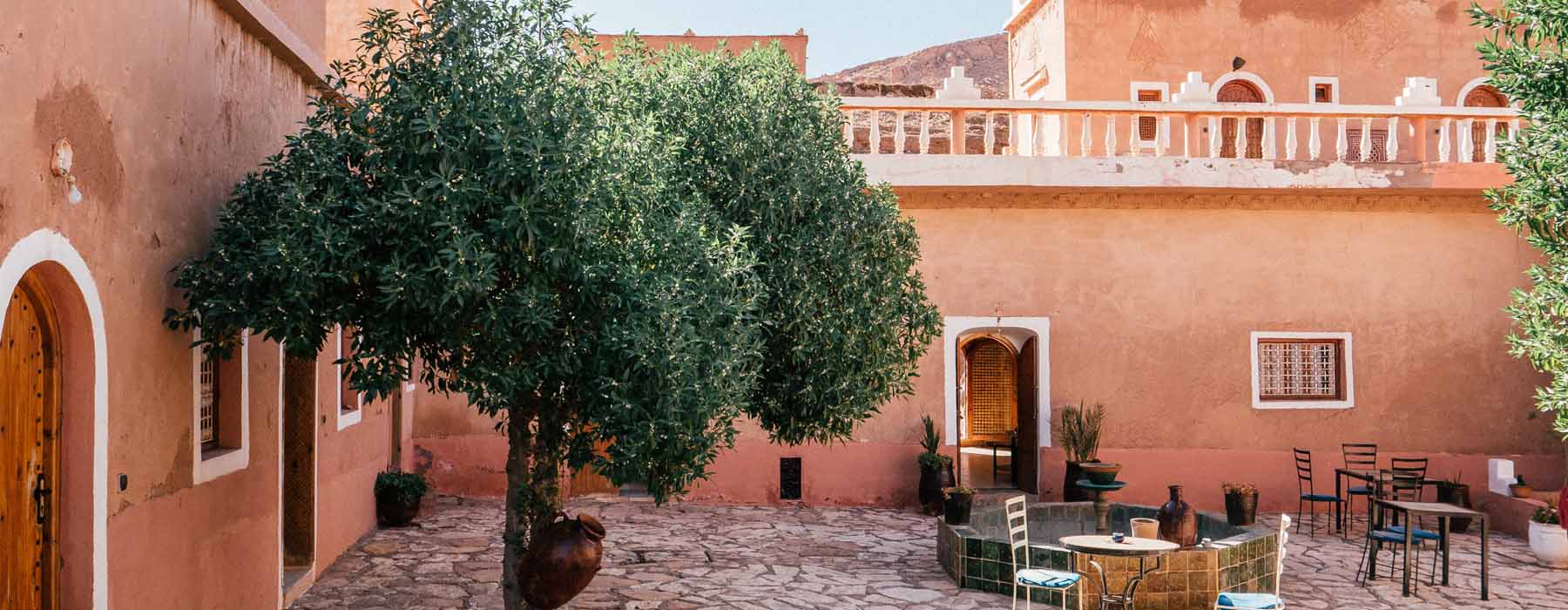
Culture Morocco
- Morocco Holidays
- Essaouira & the Coast
- Marrakech & Surrounds
- Northern Morocco - Cities & Medinas
- Ouarzazate & the Southern Desert
- Couples Holidays
- Cultural Holidays
- Family Holidays
- Luxury Holidays
- October Holidays
- Winter Sun Holidays
36,676,105 (2019)
Official language
Arabic and Berber
Language spoken
In addition to Arabic and Berber, French is widely spoken. Spanish and English are also used.
Most Moroccans are of Berber, Arab or mixed Arab-Berber descent. The Berbers were Morocco’s first occupants and they form the bulk of the population. Generally they are divided into four groups and speak four variants of the Berber language – the Rif, the Middle Atlas group, the Berbers of the High Atlas and nomadic groups of the southern provinces. Sizable minority populations in Morocco include the West African populations of Haratin and Gnawa, which emerged from a legacy of slavery, and the Jewish community, although it has decreased significantly since the 1950s.
Almost all Moroccans follow Islam and a large majority are Sunni Muslims, belonging to the Maliki school of Islamic jurisprudence. Other minority religions include Christianity, Judaism and Bahaism.
National Holidays
- January 1: New Year's Day.
- January 11: Independence Manifesto.
- May 1: Labour Day. July 30: Throne Day – the most important civil holiday in Morocco.
- August 14: Allegiance of Oued Eddahab.
- August 20: Anniversary of the Revolution of the King and the People.
- August 21: Youth Day.
- November 6: Green March Day.
- November 18: Independence Day.
Religious holidays
Dates vary. Al-Hijra is the Islamic New Year. Ramadan and then Eid al-Fitr marks the end of Ramadan. Eid al-Adha commemorates the sacrifice of Abraham. Eid al-Mouloud celebrates the birth of the Prophet. Ashura commemorates the assassination of Hussein and the dead in general.
Perched between Europe and Africa, Morocco’s history is defined by its geography. Throughout time it has been a prized location for the empires that ruled across the Mediterranean. After the Roman conquest of Morocco at the beginning of the Christian era, the country suffered many foreign invasions – the Vandals in 429 AD, the Byzantines and then the Arabs who invaded in 705 AD and introduced Islam and Arab culture. With a solid base in Morocco, the Arabs then invaded Spain in 711 AD and conquered most of it. At the end of the eighth century, Idriss, descendant of the Prophet Muhammad’s daughter Fatima, found refuge in Morocco. Recognised as a powerful figure across northern Morocco, he unified the country and moved the capital to Fez. After his death, his son Idriss II extended their influence into Europe. In the 11th century, the Berber Almoravids took power into their hands and founded Marrakech.
A century passed and a movement called the Almohads toppled the Almoravids and founded a new dynasty. By the 13th century however, the Almohads had lost most of the Muslim territory to Spanish Christian forces and only Grenada remained. The Merinids overthrew the Almohads, captured Marrakech and put an end to the dynasty. The cycle repeated and the next to conquer were the Wattasids who began to seize power in 1240 and were ruling Morocco by 1469. The 16th century of Morocco saw new leaders of Arab descent and in 1525, the Saadians took control of Marrakech and took the country in hand, settling border disputes with Portugal.
By the 17th Century however, the Saadian empire dissolved and the Alawites made their mark, creating an army and strengthening the state. In 1912, the Treaty of Fez forced Morocco to become a French protectorate, while a later agreement granted Spain a zone of influence too. Colonial settlement began with road construction, city planning, development of campaigns and some intelligence domination, but the Moroccan people resented their loss of independence.
After World War II the desire for independence increased among Moroccans and between 1956 and 1958 Morocco gained independence back from France and Spain. The Sultan Mohamed V drafted a constitution that brought the country into the modern era and following his death, King Hassan II becomes responsible for delivering it and he reigned until 1991. His son, Mohammed VI became king in 1999 and on his accession promised strong political action and to improve conditions. In 2011, the Arab Spring protests sparked a series of constitutional reforms, which included giving more power to parliament.
Morocco is a constitutional monarchy. Parliament is bicameral – there are 325 members of the House of Representatives, elected every five years by national vote. The House of Councillors is comprised of 120 members, elected indirectly by local authorities, professional organisations and trade unions every six years.
Famous Morrocans
Apart from the country’s king and various historic Sultans, Morocco’s most notable figures include two brilliant writers, Tahar Ben Jelloun (born 1944) and Driss Chraïbi (1926-2007), whose work are a well-known take on the rich cultural life of Morocco. The great athlete Hicham El Guerrouj (born in 1974), a now retired middle-distance runner, is an Olympic and world champion and the current world record holder of the outdoor 1500 meters, mile and 2000 meters events. Nass El Ghiwane, a Moroccan musical group formed in Casablanca in the 70s, were dubbed the Rolling Stones of Africa. The band used traditional instruments to reflect contemporary issues and were widely played throughout the country and internationally.
Morocco is a tolerant, yet traditional culture with strong values and there are one or two etiquette rules to follow to ensure a smooth and respectful trip. As a Muslim country, clothing should be modest as many people are offended by clothes that do not cover legs and shoulders, especially in rural areas. In general, shoes should be removed before entering a room – take cues from any shoes lined up at the doorway. If you’re invited to share a family meal, wait until the host had said ‘bismillah’, which means ‘in the name of God’ before starting.
Ramadan is practiced by almost all Moroccans and during the month of fasting, Muslims are prohibited from drinking, eating and smoking from sunrise to sunset. During this time, travellers should avoid eating and drinking in public.
Tipping is now a staple of African life and Moroccans who provide a service, and do so well, will expect a tip in return. If service from a waiter, taxi, porter or driver is good, then a few dirhams will go a long way in making your thanks known.
In Morocco, access to most mosques and holy places is forbidden to non-Muslims, much to the disappointment to many tourists. There are some exceptions, but the majority of holy buildings should be admired from the exterior.
Morocco is a country filled with marvellous crafts and there are extraordinarily varied treasures to be found in the souks. From shiny silver jewellery and a-class leather to intricate carpets and wooden carvings – haggling for souvenirs is an art form in Morocco. Pick up a chiselled tray of copper and bronze, engraved or hammered to perfection or admire the teetering towers of baskets in all shapes and sizes that adorn every corner of the markets. You’ll come across some of the best potters in Morocco in Fez, Meknes, Safi and Marrakech – true master artists whose dishes, jars and pitchers will dazzle. Take home an abundance of spices to recreate the inevitable taste sensations Morocco will delight you with.
Moroccan cuisine is a rollercoaster ride of spices and surprising flavour combinations – it’s playful, experimental and contains some of the world’s most mouth-watering dishes. The tagine, Morocco’s punchy version of a stew, is the country’s most famous dish and it gets its name from the pot in which it is cooked. Meat (usually lamb or chicken) and a whole host of spices, nuts, fruits and vegetables are slowly cooked together and served with warm crusty bread. It’s a version of Moroccan heaven on a plate and no two tagines are ever the same. Another of the country’s classics, couscous, is eaten salty or sweet and sour and is a fluffy, flavourful pleasure served with vegetables and meat.
Pastilla is a lavish sweet and savoury pastry pie with stuffed pigeon, chicken or fish with onion, lemon, eggs and spices then dusted over with sugar and cinnamon. Harira is a favourite sunset fast-breaker during Ramadan and it’s a comforting soup rich with tomatoes, lentils, chickpeas and lamb. If you’re still hungry after a Moroccan feast, the pastries won’t disappoint and many are sweet almond and honey flavoured.
Mint tea reigns supreme in Morocco and it is the drink of choice everywhere. Consumed at all times of the day, it’s a Moroccan tradition and is usually heavily sweetened with sugar.
Useful information
Practical guide.
- Travel Advice & Information
- Passport & Visa requirements
Morocco in Context
- Things to know before travelling
Things To Do In Morocco
Morocco holiday ideas.
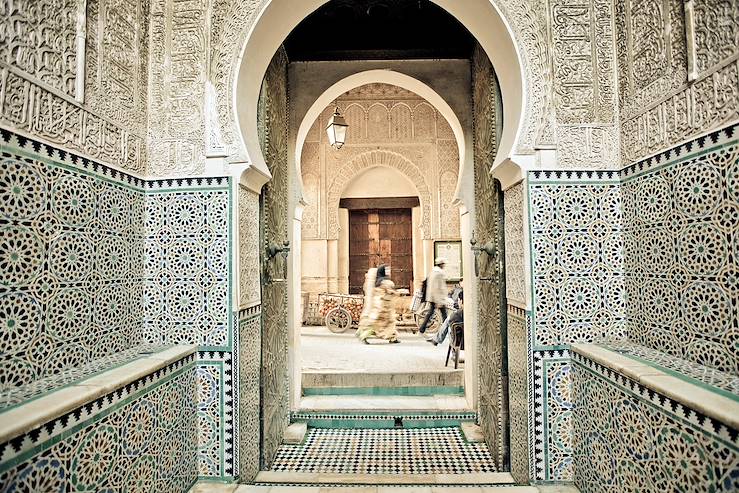
Nights in the Medina: A Big Short Break in Fez
Spend a weekend in Morocco’s cultural and spiritual capital
4 days, from £ 780 to £ 1,130
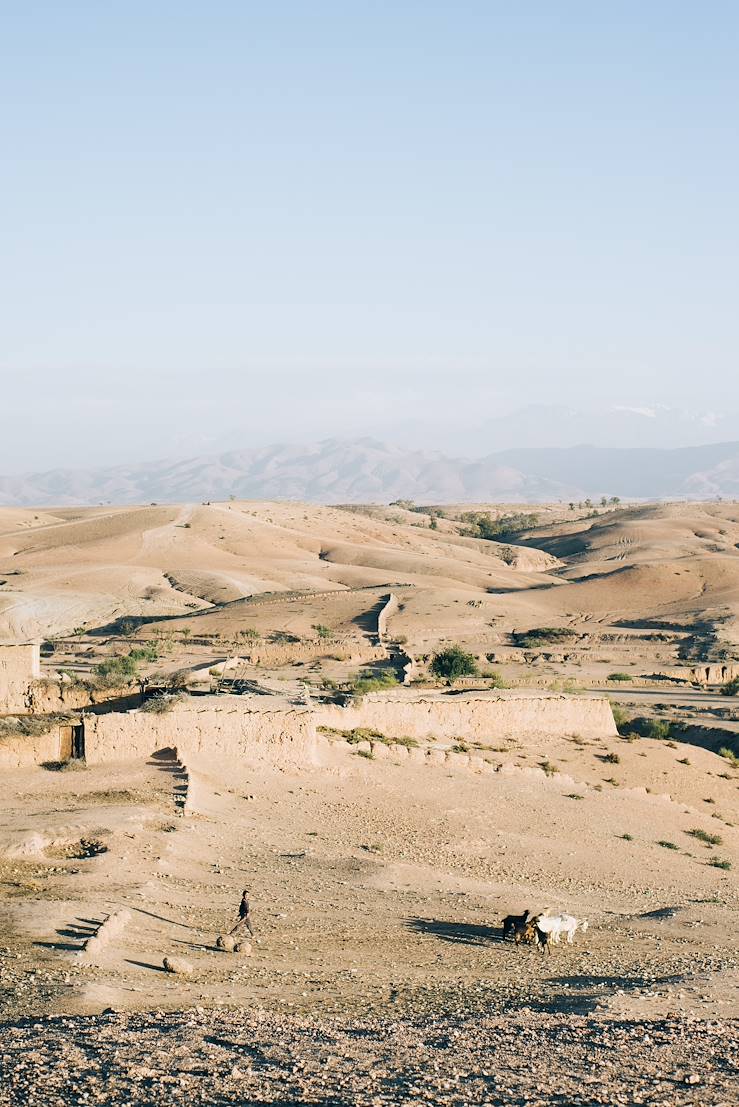
Morocco - Marrakech
Marrakech for two: a secret riad & berber culture.
The cosy atmosphere of your riad, select accommodation in the heart of the medina (old town)
3 days, from £ 1,160 to £ 1,520
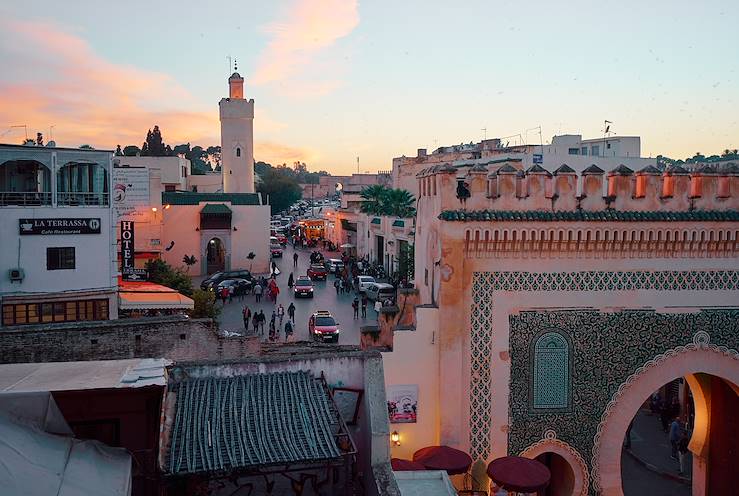
Tangier - Chefchaouen - Fes
Northern morocco: blue towns and coastal cities.
Lose yourself in Tangier’s labyrinthine medina.
10 days, from £ 1,300 to £ 1,800
Understanding your Needs
Our team of destination experts will start by getting to know you and your unique requirements for your holiday
Personalisation
We work with you to build an ultra-personalised holiday itinerary with your choice of accommodation, experiences and activities
Our Services
All of our holidays include little extras designed to make a big difference to your trip, from fast-tracking you through airport check-in and security to our network of local concierges.
+ 44 (0) 20 3958 6120
- Skip to main content
- Skip to secondary menu
- Skip to primary sidebar
- Skip to footer
Morocco Travel
Places to visit, Things to do.
Moroccan People and Culture
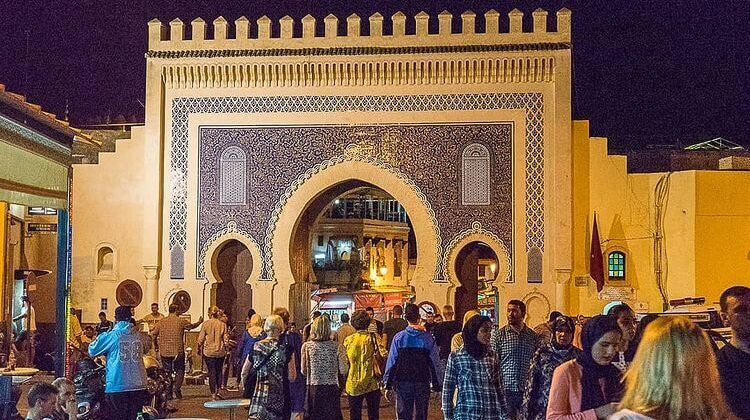
Morocco has established itself as a crossroad of civilizations, who, over the course of hundreds and even thousands of years, have managed to leave their mark on the cultural landscape of the kingdom.
So it’s only natural that Moroccan people mirror this diversity in their customs, traditions, and lifestyles.
Today the country boasts a population of 36.7 million, 4 languages, 9 world heritage sites, and 3 religions -Islam as predominant along with Christian and Jewish minorities.
Here’s a general overview of Moroccan people and culture
Table of Contents
Ethnicity, Language and Religion
Ethnic groups in morocco.
- The two major ethnic groups in Morocco are the Arabs and the Berbers.
- The Arabs arrived as early as the late 8th century and conquered much of the coastal region. They established dynasties in Morocco and together with native Moroccan Berbers, extended control to what is now southern Spain and Portugal.
- There was a lot of intermixing between locals and Arabs, and today many Moroccan people claim mixed ethnicity, with only a few identifying as pure Arab.
Language and Religion
- Over time, Arabic became the primary language, but the most significant import of the Arabs was Islam that shaped the Moroccan Culture.
- Today, 99% of Moroccan people are Muslim. Most are Sunni Muslims, the most common sect worldwide.
- A small minority are Shia, the second most common sect worldwide, and a few follow Sufism, a branch of Islam known for its sacred poetry and mysticism.
- In the past, Morocco had a significant Jewish population, but many migrated to Israel and other countries. Only a few thousand Jewish Moroccans still live in the country.
- There are also a few hundred thousand Christians living in Morocco, mostly of European descent. You’ll see mosques in every neighborhood, and a handful of churches and synagogues in larger cities.
Berber culture and influence
- People tend to associate North Africa primarily with Arab culture, since Arabic is the official language and most Moroccan people follow Islam.
- However, Berber culture remains a very strong, and perhaps in many ways the primary influence on Moroccan culture.
- Since the Arabs focused their conquests on the coastal regions, certain parts of the interior were less affected, and retained a stronger sense of indigenous identity.
- When traveling in Morocco, you may notice that rural mountain and desert regions are more clearly Berber than other parts of Morocco.
- As much as 30% of the population of Morocco is of pure Berber heritage, and the vast majority of the remaining 70% has at least some Berber ancestry.
- There are many Berber groups in Morocco with different languages and customs, including the Drawa, the Shilha, the Riffia, and the Sanhaja. They all use the general name Amazigh, meaning free people, to denote their identity as indigenous Moroccans.
Recent influences
- Both France and Spain colonized parts of the country, leaving lasting impacts in language, architecture, education systems, law, art, and cuisine.
- Even though Morocco gained full independence in 1956, the local dialect of Arabic is peppered with French and Spanish words.
- Morocco is also increasingly a destination for Africans from other countries seeking better economic opportunities. Immigrants from Senegal and Cameroon settle in northern Morocco, either permanently or on their way Europe, bringing with them new customs and vibrant styles of art, music, and dance
Customs and Traditions
Morocco is a land with an expansive history of customs and traditions.
The country is worldly renowned for its incredible hospitality and its impressive blend of cultures and religions. It is also a land of extraordinary contrasts and remarkable diversity.
What could be more emblematic of Moroccan people, customs and cultural heritage than a traditional Moroccan wedding .
Moroccan weddings are an elaborate affair that celebrates unity, love, happiness, and prosperity.
It is a vibrant commemoration of sanctity and virtue that engages all five senses, through the colors, the music, the clothing, and the food.
People wear their most luxurious and extravagant frocks, with exquisite beaded caftans and fascinating sequined takshitas in vibrant colors.
Weddings aside, the variety in traditional Moroccan clothing is specific to each occasion, based on how casual or formal it is.
Djellabas are the most relaxed form of traditional clothing, you can find people sporting while running for errands or while visiting family and friends.
Whereas caftans and jabadors can be worn for religious holidays or engagement parties and takshitas are reserved for more formal settings.
Moroccan Cuisine
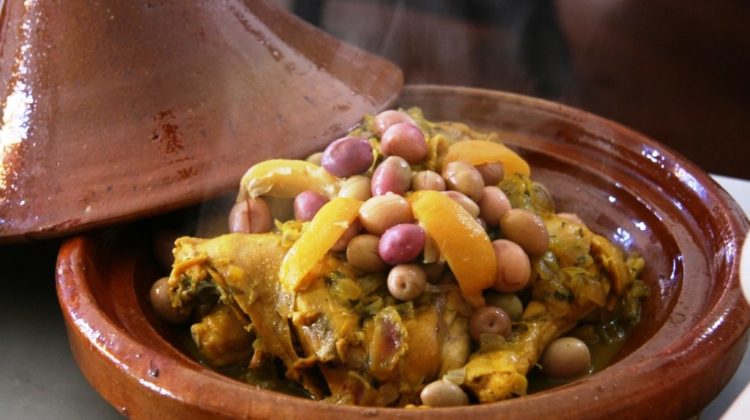
With centuries of trade, conquest and immigration, Moroccan food preparation and consumption habits have been frequently shaped and reshaped.
The region takes pride in its culinary scene with its exquisite flavors and tantalizing aromas. Geographic diversity and climate greatly allow for the cultivation of an impressive range of foods and ingredients.
Because of its strategic location, Morocco has been part of the spice trade route in the past. This marked a truly defining period in the history of North Africa and Morocco in particular.
It also helped broaden the country’s culinary scope to incorporate new ingredients, herbs and spices that have now become a staple in Moroccan cuisine.
Moroccan people may differ in terms of their ethnicity, religious beliefs, or political affiliation, but they do share an avid appreciation for food and cooking.
Tajine, Couscous, Pastilla, and Harira are testimony of regional influences combined with ancient cooking traditions.
A lot of Morocco’s staple dishes, lamb tajine with dried apricots or couscous with caramelized onions and raisins, for example, consist of blending sweet and savory flavors together, a tradition that goes back to Ancient Roman cuisine.
When you try to dissect the history of any traditional Moroccan dish, you will find hints of Sicilian, Maltese, Greek, and Arab influences.
Related Post: Moroccan Cuisine
Music Scene
The multi-ethnic background of Moroccan culture cannot be more evident than in the country’s musical landscape and dance forms.
Despite the Western music scene’s heavy impact on contemporary Moroccan artists, there has been a recent yearning for more traditional and authentic Moroccan music .
This longing to revisit one’s history is encapsulated in the revival of Gnaoua , Berber, Rai, and Andalusian music through annual concerts and festivals dedicated to these ethnic genres.
A lot of young musicians and artists have also contributed to this revival by performing covers of traditional songs using more modern-fitting rhythms and instruments to appeal to the youth.
Like a lot of customs and traditions, Moroccan music also varies depending on the geographic location of each region.
- Andalusian music, a mixture of Spanish and Arab influences, dates back to the 9th century. It’s considered to be Morocco’s classical music, and it’s generally played on special occasions and national celebrations like Eid.
- Chaabi music is the equivalent of pop, it’s very lively and energetic and is usually played in weddings, baptisms, and parties to urge people to dance and have fun.
- Berber music is exceptionally ritualistic, it requires its own ceremony with intricate dance choreographies that exude an eerie, almost supernatural atmosphere.
- On the other hand, Gnaoua music is a mixture of Sub-Saharan/ African, Berber, and Arab music. Gnaoua musicians heavily rely on drums and castanets. It’s a languidly mystical genre with African lyrics that has recently been mixed with notes of jazz and blues.
Architecture and Art
Morocco is renowned for its stunning architecture and traditional artistry. The country’s architecture is characterized by intricate tilework, stucco carvings, and geometric patterns.
The historic cities of Marrakech, Fes, and Chefchaouen are known for their well-preserved medinas, or old towns, which are UNESCO World Heritage Sites. Moroccan art also includes calligraphy, ceramics, and intricate textiles, all reflecting the Islamic influence.
Related Post : Moroccan Architecture
Conclusion:
Morocco, with its diverse people, rich history, and captivating culture, is a land of contrasts and complexities. From the bustling souks of Marrakech to the serene beauty of the Sahara Desert, from the flavors of its cuisine to the rhythms of its music,
Morocco offers a captivating journey of discovery. The Moroccan people and culture reflect a harmonious blend of traditions and influences that make this North African nation a remarkable and inviting destination for travelers and a source of pride for its citizens.
Welcome to Moroccopedia
- Privacy Policy
- Morocco with Kids
- Moroccan Tea Culture
- Exploring the Imperial Cities of Morocco
- Discover the World of Moroccan Leather
- Casablanca or Rabat

Taste of Maroc – Moroccan Recipes, Moroccan Culture, Moroccan Lifestyle, and Moroccan Travel
Pantry essentials.

How to Make Preserved Lemons

Moroccan Harissa Chili Paste

Ras El Hanout Spice Mix
Learn about ashura.

Day of Ashura – Religious Meaning and Moroccan Traditions

Krichlate Recipe – Moroccan Petite Shortbread Cookies for Ashura
Krichlate, qrishlat, fqiqssat or q’iq’ats (كعيكعات) are crunchy miniature shortbread cookies. They’re sold in Moroccan…

Ashura in Morocco: A Puzzling Celebration
Explore by category.

Moroccan Breads to Try

Krachel Recipe – Moroccan Sweet Rolls with Anise, Sesame and Orange Flower Water

Moroccan Khobz Recipe – Basic Moroccan Bread Recipe

Batbout – Moroccan Pita Bread Recipe
Classic moroccan recipes.

Roasted Chicken with Preserved Lemons & Olives

Casablanca Style Couscous with Seven Vegetables

Seafood Bastilla with Shrimp, Calamari & Fish
Popular in culture & travel.

Tipping in Morocco – How Much to Tip Tour Guides, Drivers, Waiters and Others

Traveling to Morocco in Ramadan

Cross-Cultural Marriage – Eight Issues to Consider Before Tying the Knot
Our latest posts.

Moroccan Mallow Salad Recipe – Khoubiza or Bakkoula

Moroccan Henna Styles and Traditions

Moroccan Orange Cake Recipe – Meskouta with Oranges

Moroccan Avocado Milkshake or Smoothie Recipe

Moroccan Zaalouk Recipe – Eggplant and Tomato Salad or Dip

Moroccan Sardine Balls Recipe – Fish Meatballs in Tomato Sauce

Moroccan Dried Fava Bean Dip or Soup – Bessara (Bissara)

Moroccan Beauty Secrets You Can Try at Home
Privacy overview.

How a group tour changed my whole approach to travel
I 've always considered myself a fiercely independent traveler. I've navigated more than 50 countries on my own, and while I have sometimes booked short excursions, usually for a day, it had never occurred to me to book a group tour. That changed when I decided to take two of my children on a family tour with Intrepid Travel .
I had planned on spending our winter break in the Middle East but changed my mind at the last minute due to safety concerns . Because of the abrupt change, I knew I wouldn't have time to plan an itinerary, book hotels and arrange transportation before our departure date. However, I didn’t want to let that stop me from having an adventure. I'm glad I took a chance on a group tour because it changed the way I travel. Here's how.
BEST OF THE BEST: 15 Best Group Travel Companies for Guided Tours
Start the day smarter. Get all the news you need in your inbox each morning.
The trip planning was stress-free
I spent a little time comparing tour companies but quickly honed in on Intrepid. The company offers a variety of itineraries for families at different price points, and a few of my friends had been on its tours and had a good experience. I also liked that Intrepid offers specialized tours for different types of travelers, including family tours .
At first I planned on an "original" style family tour but upgraded to a "comfort" tour, which included more activities and meals along with upgraded accommodations. Although it cost more, the company's 10-day Morocco Family Holiday tour was still within my budget and looked like a good value.
BEFORE YOU GO: The 5 most important questions to ask yourself before booking a tour
Once I committed to a tour, my planning was essentially done. That was a huge relief. I normally spend hours searching for hotels , figuring out some must-do activities in every location along with some off-the-beaten-track attractions, researching transportation options, and gathering restaurant recommendations. Although I often find it's fun, it’s also time-consuming and can become draining for trips that involve several stops.
Even though a group tour was not exactly what I would have planned on my own, Intrepid's Morocco itinerary was fairly close. I thought giving up some control was well worth the trade-off of not having to do all the planning on my own. Because Intrepid uses local teams based at its tour destinations to plan trips, I also hoped having a local involved would bring me to places I never would have found on my own.
SAVE MONEY: Kids stay free at these 10 all-inclusive family resorts
Instead of reading hotel reviews and booking entry tickets, I spent the weeks leading up to my family vacation learning more about Moroccan culture. I knew this would enrich my experience more than figuring out all of the details for a trip abroad to run smoothly. I'm usually a mix of excited and stressed in the week or two leading up to a big trip. This time I was mostly excited, and my stress was at a minimum.
Though I won’t stick exclusively to group tours in the future, this trip taught me to not sweat the small stuff so much. I don’t need to spend so much time finding the perfect hotel or restaurant to have a great trip.
Group trips are fantastic for solo travelers and parents traveling on their own
Before I had a family, I often traveled on my own. Though I enjoyed solo travel , it was lonely at times, even more so when I stopped staying at youth hostels and lost access to the fantastic communities they provide. Now I frequently travel with my two younger children. They are fantastic travel companions, but on longer trips I sometimes find myself longing for adult interaction or an extra pair of hands. Additionally, even though my kids usually get along well, they sometimes get sick of each other in the absence of any other playmates.
TRAVEL WITH TEENS: 10 best vacation ideas for families with teenagers
On my Intrepid trip, I had other adults to talk to throughout the day. That was a refreshing change from my usual experience of going a week or more without speaking to another adult for more than five minutes, usually for transactional matters like checking into a hotel. My kids also quickly made friends with the other children on the trip. Not surprisingly, all of the families on the trip had similar interests and an adventurous spirit. My children and I were the only Americans in the group, and it was interesting learning more about life in New Zealand, Canada and Australia from the other families.
The parents in the group quickly started leaning on one another for support. One mom, also traveling alone with her children, asked me to take one of her daughters on an outing so she could get some one-on-one time with her other child. I asked a different mom to keep an eye on my son while I packed our things for the next day. It was nice not feeling as if I was on my own.
UNIQUE TRIPS: Hate bus tours? These 7 unique guided tours were made for you
This "it takes a village" spirit is something I want to bring with me in my future travels. Although it’s not possible to replicate the experience of traveling with other families, it is possible to seek out connections away from home. For example, on a recent trip, my son wanted to play soccer with local children who lived near our hotel. Instead of rushing him away so we could squeeze in another activity, I let him play. He wound up meeting up with the other kids every night we were there, sharing candy and communicating with an app. The nights playing soccer were a highlight of that trip for him and something I probably would not have let him do before my experience with a group tour.
I appreciated a slower pace
I have serious FOMO and often pack too much into my days when I travel. When I first reviewed the itinerary, I noted right away that it had downtime and even an entire free afternoon built into the trip. Though I know many people enjoy that balance, I was worried I would feel bored and come away feeling as if I had traveled halfway around the world and missed seeing all there is to do.
TRIP REVIEW: Adventures by Disney’s Peru tour is a riveting family adventure
The reality is it’s impossible to do everything. Trying is exhausting and impossible. There is always something left on the to-do list at the end of the trip. It was refreshing to go into a trip not trying to see an entire country in two weeks and being OK with that from the outset.
Though there were a couple of other things I would have liked to have squeezed in, I was very happy with the balance of activities and downtime. Other than all-inclusive family vacations and trips to family resorts , I normally don’t schedule time to just relax while I am traveling. It was really nice to have time to read and play UNO with my kids. I also liked that Intrepid had a couple of optional activities for those of us who didn’t want quite as much downtime as others.
MONEY MATTERS: How much should you tip on a guided tour? All your gratuity questions answered
I do still feel pressure to see and do everything when I travel, but going on a group trip helped me see the value in traveling at a slower pace. Some of my favorite moments from my Intrepid trip happened during scheduled downtime; they gave me and my children time to just enjoy being with one another without the pressures of work and school. It’s a lesson I’ve tried to carry with me as I’ve planned future trips.
Learning from a local is invaluable
One reason I chose Intrepid is the company uses all local guides, and most tours use the same guide throughout the trip. It may sound obvious that learning from locals is the best way to get to know a country, but I had underestimated just how valuable traveling with a local guide would be.
TOUR REVIEW: Adventures by Disney’s South Africa tour is a lesson in culture, history, and beauty
I learned much about Moroccan culture through our tour guide, who was always willing to answer questions about his life and traditions. He even brought us to his family home to meet his parents and niece, which was a very special experience. Aside from being able to share the history of everywhere we visited, I also liked that our guide warned us about scams to watch out for, shared the tipping culture and gave advice on bargaining. He was also helpful when it came to practical matters like finding an ATM.
For future trips, I will be more open to taking guided tours with local guides, even if it’s just for a few hours. I will also make it a point to try to talk to more locals, as long as I can do so without bothering them too much.
Even though it wasn’t what I had originally planned, not only did I have a great experience on my trip with Intrepid, it has also forever changed the way I plan to travel.
How a group tour changed my whole approach to travel originally appeared on FamilyVacationist.com .
More from TourScoop:
- 9 best travel companies that specialize in women-only tours
- 8 best senior travel tour companies
- 4 great tour companies with independent tours
The views and opinions expressed in this column are the author’s and do not necessarily reflect those of USA TODAY. FamilyVacationist.com and TourScoop.com are owned and operated by Vacationist Media LLC. Using the FamilyVacationist travel recommendation methodology , we review and select family vacation ideas , family vacation spots , all-inclusive family resorts , and classic family vacations for all ages. TourScoop covers guided group tours and tour operators , tour operator reviews , tour itinerary reviews and travel gear recommendations .
This article originally appeared on USA TODAY: How a group tour changed my whole approach to travel
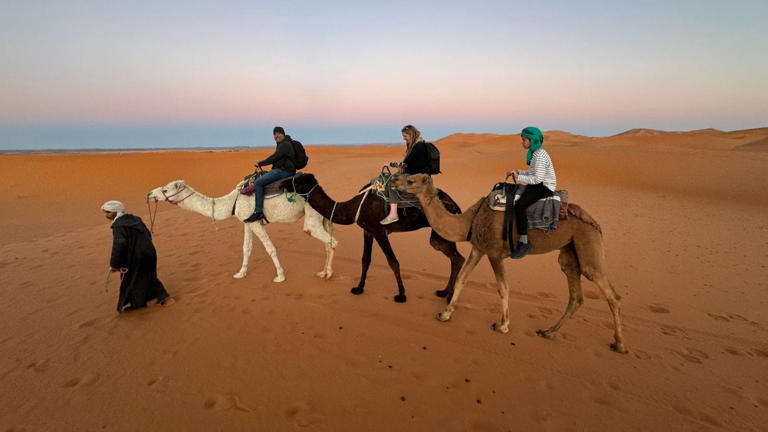

IMAGES
VIDEO
COMMENTS
At Morocco Culture Travel, we invite you to explore Morocco's unique heritage and vibrant culture. Whether you're an adventurous soul, a history buff, a food lover, or a culture enthusiast, we will provide unforgettable experiences! Your comfort and safety are our top priorities. We invest constantly on our diversified transportation fleet ...
To learn more about Moroccan Culture you can find some Moroccan Travel Guidebooks specialy selected for you here. Moroccan Hospitality 'Grab' in Marrakesh - He distributes water. This is another one of the country characteristics, its citizen's hospitality. Moroccan people are probably ones of the nicest people you'll ever meet!
4.4 (44 reviews) Our Nomadic Tours Morocco Encompassed 15 day tour with our guide Aissa was excellent. We hit all the major sights and varying terrains of Morocco.Our guide Aissa brought the history and culture to life. He was excellent, so knowledgeable and really made the trip so memorable.The entire trip was well organized thanks to Aissa ...
Day 1 -Welcome to Morocco and on to Ait Benhaddou. Start your cultural tours in Morocco with Morocco Culture Travel! Your outstanding experience begins from the very beginning. Arrive at the Marrakech Menara International Airport, where you will be met with your driver and guide. From the airport, hit the road and head across the Atlas ...
Unique crafts and traditions. Ouarzazate, is the heartland of the southern region, where kasbahs, oases, arid mountains, are all elements that embellish the splendid city. Revel in the lights and the sumptuous settings that one hosted Game of Thrones, Alibaba, Gladiator, and many more.
The Kairaouine Library and Mosque houses the world's oldest library and is Morocco's renowned spiritual and study center. Planning tip: While you're in the area, visit the imperial city of Meknes and the fantastically preserved ancient Roman ruins of Volubilis. 8. Tangier.
Morocco. Africa. Check out this year's Best in Travel winners. A country of dazzling diversity, Morocco has epic mountains, sweeping deserts and ancient cities, and it greets travelers with warm hospitality and the perfect glass of mint tea. Best Time to Visit. Best Places to Visit.
Explore the Best of Morocco's Diverse Culture Introduction: A Melting Pot of Cultures. Morocco, nestled between the azure waters of the Atlantic Ocean and the towering peaks of the Atlas Mountains, is a wonderland teeming with cultural riches, historic landmarks, mouth-watering cuisine, and bewitching landscapes.It's a place where time seems to stand still, where the ancient and the modern ...
Recently updated on August 14th, 2023 at 03:19 pm. With beautiful scenery, vibrant cities, rich culture, delicious cuisine and friendly locals, Morocco is an incredible destination. It's also home to many unique Moroccan traditions and etiquette rules, so it's best to brush up on your cultural knowledge before you visit.
Find the perfect place to stay. Whether you prefer boutique hotels, luxury resorts, or budget hostels, we have recommendations for you. Discover Morocco's treasures with expert guides. Delve into the heart with locals' insights. Culinary hotspots off-the-beaten-path wonders await...
The country's culture is a blend of Arab, Amazigh, Jewish, African, and Western European cultures. Morocco's unique culture is shaped by a convergence of influences throughout history. Morocco's culture is known for its hospitality, music, art, and cuisine. The country has a rich history and a deep appreciation for tradition.
In medinas, it's helpful to know that if the street sign is a hexagon, it's a dead end. If it's a square, it's a through street. Introducing Morocco. 16. Don't drink the tap water. Morocco's tap water is not safe to drink. Bring a water bottle with a filter to avoid buying plastic. 17.
Embark on an enveloping wellness break in Morocco! Do you travel to quench your thirst for discovery and adventure, but also to feel good about yourself? ... Culture Tbourida : Moroccan equestrian art. Tbourida : Moroccan equestrian art The Tbourida, derived from Baroud which means "gunpowder", is an ancient equestrian art, dating from the 15th ...
Morocco Travel Guide. Your ultimate Morocco travel guide, with tips, things to do, and best things to see in Morocco. Great for first-time and returning travelers. Morocco is a fascinating multicultural country blended from African, Arab and European influences. It is our closest link to the continent of Africa and a diverse holiday destination.
Each city offers something different - Marrakech has vibrant souks and markets full of local products; Fez is steeped in ancient history and culture; Meknes is known for its grand gates and palaces; Chefchaouen has charming blue-washed buildings; while Essaouira has a laid-back atmosphere with plenty of beaches.
The best way to travel between Moroccan cities is by train. Morocco now has Africa's fastest trains traveling at 300km/h (186mph) linking Tangier, Rabat and Casablanca every hour over a new high-speed line. Classic trains link northern Tangier and Casablanca with Meknes, Fes and Marrakech.
Etiquette. Morocco is a tolerant, yet traditional culture with strong values and there are one or two etiquette rules to follow to ensure a smooth and respectful trip. As a Muslim country, clothing should be modest as many people are offended by clothes that do not cover legs and shoulders, especially in rural areas.
The Moroccan people and culture reflect a harmonious blend of traditions and influences that make this North African nation a remarkable and inviting destination for travelers and a source of pride for its citizens. Filed Under: Moroccan Culture. Morocco is incredibly geographically diverse. This diversity extends to Moroccan people and their ...
Marvelous Morocco & Granada Spain April 2020. This extraordinary 9 day/8 night travel will include a full view of Moroccan culture, through Casablanca, Rabat, Fes, Chefchaouen, Tangier and a 2 day tour of Granada Spain.
Keep up with all things Moroccan! Explore Moroccan cuisine, learn about Moroccan culture, and get tips on living in and traveling to Morocco. Taste of Maroc - Moroccan Food, Culture, Lifestyle and Travel
TOUR REVIEW: Adventures by Disney's South Africa tour is a lesson in culture, history, and beauty. How a group tour changed my whole approach to travel originally appeared on FamilyVacationist ...